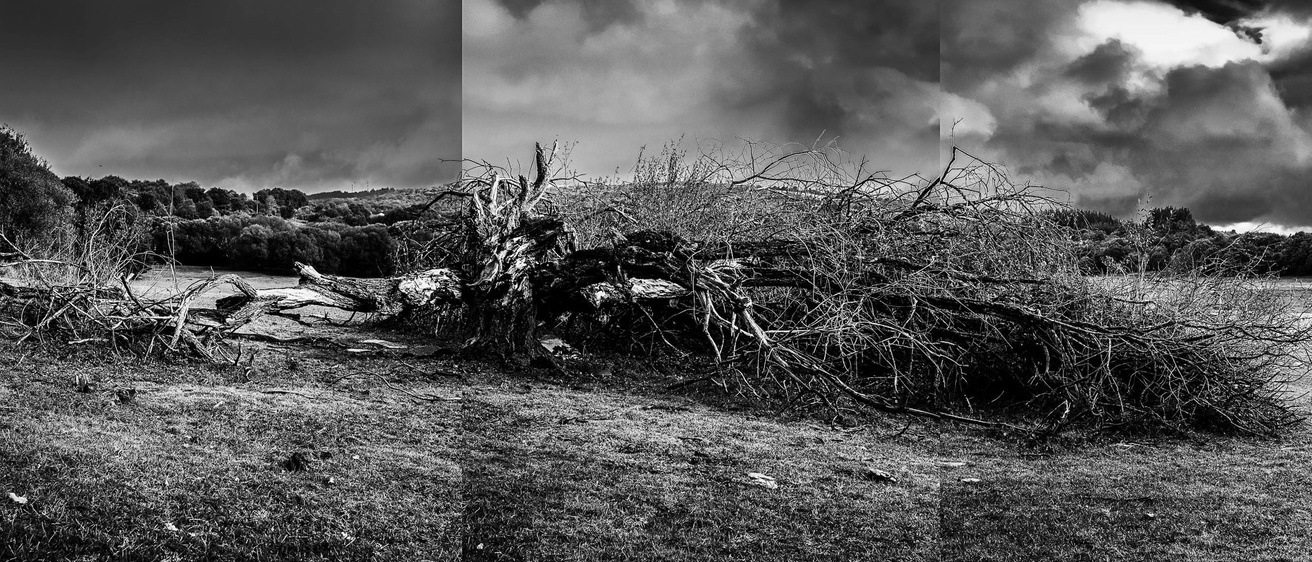Honoring Iraqi Academics
On display January - June, 2023 in the Old Capitol Museum's Hanson Gallery.
The Pentacrest Museums are honored to present Shadow and Light: Honoring Iraqi Academics with hopes of creating space for contemplation and reflection of academic freedom, intellectual bravery, and international solidarity.
The Shadow and Light installation is a compilation of 30 photographs accompanied by personalized narratives, each memorializing one of the more than 700 Iraqi academics assassinated between 2003-2012. The exhibition features the stories of educators, scholars, and artists whose lives were lost to violence prompted by the U.S. led invasion, occupation, and resulting targeted violence in Iraq.
“During their lifetimes, the men and women memorialized in this exhibit enriched diverse fields of knowledge —from history to calligraphy to the study of bees. Each assassination represented an attack on the underlying principle of education—to share knowledge—and served as a threat to scholars throughout Iraq that they were at risk.”
—Beau Beausoleil, Project Director, and
UC Santa Barbara Library Curators Mona Damluji and Heather Hughes.
The work exhibited was compiled by Beau Beausoleil, a poet and activist in the Bay Area. Beau is the founder (in 2007) of an international project that has used art and writing to address the implications of the car bombing of al-Mutanabbi Street (the street of the booksellers) in March of 2007 in Baghdad, Iraq. He is the author of 15 books of poetry including a volume entitled, Letters to Iraq (Intermittent Press -2020), written in response and solidarity with the October 2019 Revolution in Iraq.
To create the project, Beau collaborated with artists from all over the world to pick a name of an assassinated Iraqi academic to memorialize with a photograph and a personal narrative. The Pentacrest Museums further collaborated with Beau on a selection of these individuals to be commemorated at the Old Capitol Museum.
Virtual Gallery
Use the drop-down menu to explore pieces from this project featured at the Old Capitol Museum in 2023. Pieces include artwork, artist information, the name and context provided to the artist about a particular Iraqi academic whose life was lost, the artists' statement in reflection, and a translation.
Virtual Gallery
#1 Abbas al-Attar
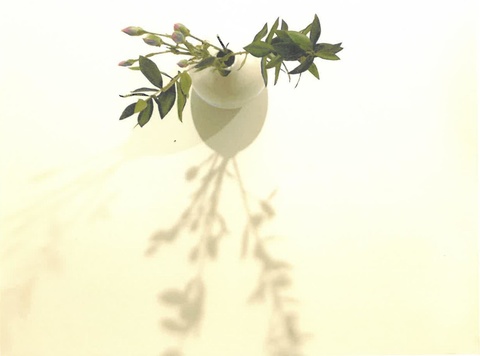
Artist Information:
Tania Baban - Iraq/USA
“Khayal” (Arabic: Shadow/Ombre)
inkjet printing on matte photo paper; color hand tinting over image
8.5 x 11 inches
Commemorating:
Abbas al-Attar, PhD in Humanities. Lecturer at Baghdad University’s
College of Humanities. Date of death unknown.
Artist Statement:
I chose Abbas al-Attar because of his field of study: the “Humanities.” I know little else about him, neither the date of his death nor the circumstances. And yet he was someone to someone—family, friends, students, colleagues—a road traveled and a life ended too soon.
My photograph “Khayal,” shadow in Arabic, came to me when I happened to look at a vase
on my coffee table one night and saw the multiple shadows the flowers cast on the table’s surface. I paused and looked again. The flowers had not yet bloomed and no way of knowing if they would or not. I thought of Mr. al-Attar selected from the tragic list of victims. The resulting photograph reminded me of the title of this project’s call: “Shadow and Light,” known and unknown. I try to imagine the length and depth of the shadow
he left behind.
How do you honor someone you don’t know? In this case maybe you focus on what they chose to teach. Humanities: “...academic disciplines that study human society and culture... The study of how people process and document the human experience...helping us decide what is important in our lives and what can be done to make them better, what’s wrong or right…addressing challenges we face together in our families, our communities, and
as nations...”
The dark irony, shadow irony, is not lost on me. There’s our shared humanity and the violent inhumanity of his death. And there are the humanities he taught and the silenced lectures that no one will hear or be inspired by. These opposing concepts cannot be reconciled. Today, a new invisible enemy threatens us all, our humanity and our humanities...this Earth we share.
Translation:
الصورة الفوتوغرافية للضحية:
#1 عباس العطار، حاصل على الدكتوراه في العلوم الإنسانية. محاضر كلية العلوم الإنسانية في جامعة بغداد. تاريخ الوفاة غير معلوم.
اخترت عباس العطار بسبب مجال اختصاصه "العلوم الإنسانية". لا أعرف الكثير غير ذلك عنه. لا أعرف حتى تاريخ وفاته أو ظروفها. ولكنه كان بالتأكيد يعني الكثير لأسرته وأصدقائه وطلابه وزملائه. كان عابر سبيل انتهت حياته مبكراً جداً.
سميت الصورة الفوتوغرافية "خيال". وهي كلمة عربية تعني "ظلّ". استلهمت ذلك بينما كنت أنظر لمزهرية على طاولة القهوة ذات مساء. رأيت ظل الورود على سطح الطاولة. توقفت قليلًا ثم نظرت ثانيةً. لم تزهر الورود بعد، وليس ثمة طريقة أعرف بها إذا كانت ستزهر أو لا. كنت أفكر في الأستاذ العطار، واختياره من القائمة المؤسفة التي تضمّ أسماء ضحايا. الصورة الفوتوغرافية التي التقطتها تذكرني بعنوان هذا المشروع: الضوء والظل، المعروف والمجهول. وأحاول تخيّل الخيال الذي خلّفه وراءه بعد مضيّه.
كيف لك أن تشرّف أحدهم دون أن تعرفه. في هذه الحال تختار التركيز على ما قرّروا تعليمه للعالم. الإنسانيات "المجالات الأكاديمية التي تدرس المجتمعات والثقافات الإنسانية.. الدراسات التي تغطّي كيف يتعامل ويوثق الناس تجاربهم الإنسانية.. فيساعدوننا في فهم ما المهم في حياتنا، وما المطلوب لتحسينها، ما الصح وما الخطأ، ويساعدوننا في معرفة التحديات التي نواجه في أسرنا ومجتمعاتنا وأممنا"
المفارقة القاتمة، مفارقة الظل، لم تفتني؛ ثمة الإنسانية التي نتشاركها والعنف في موته غير الإنساني. وثمة هناك الإنسانيات التي كان يعلم والمحاضرات التي أخرِست برحيله ولن يسمعها أحد أو يستلهم منها أحد. كيف يمكن التوفيق بين هذه المفاهيم المتضاربة؟ اليوم هناك عدو غير مرئي يهددنا جميعًا، ويهدد إنسانيتنا وعلومنا الإنسانية، ويهدد الأرض التي نتشارك.
تانيا بابان
العراق\ الولايات المتحدة الأمريكية
العنوان: خيال
#9 Essam Sharif Mohammed

Artist Information:
Hassan Abdulrazzak - Iraq/UK
"The Empty Museum"
Colour inkjet printing. 8.5 x 11”
Photographed 25 February 2019
Commemorating:
Essam Sharif Mohammed: PhD in history, professor in Department of History and head of the College of Humanities, Baghdad University. Murdered October 25, 2003.
Artist Statement:
I chose Essam because he was a professor of history. History is the collective memory of a nation. Therefore his murder is an act symbolic of memory erasure.
I returned to Baghdad in February 2019 after a 38 year absence. My family and I fled the country because of the Saddam regime. The few precious childhood memories of Baghdad I had, acquired a mythic quality over the years. It was getting harder to know what was real and what was imagined. My first stage play, Baghdad Wedding (Soho Theatre, 2007), was partially an act to capture those fragments of memory, to not allow them to be entirely erased.
I was very keen upon my return to visit the National Museum. The museum was looted after the 2003 invasion because American troops were more concerned with guarding the oil ministry than the museum. Staff have worked hard since then to retrieve much of what was stolen. Today it is open again to visitors. It contains Sumerian, Babylonian and Assyrian artefacts that take the visitor back to the beginning of civilisation. When you look at the artefacts of this museum, you are looking at the big bang of you. This surely makes it one of the world’s most important museums.
It therefore filled me with some sadness to see that the museum was virtually empty on my visit.
Admittedly this was on a Monday, a working day, but it was noticeable how empty the various halls were as the photographs can attest. One of the museum guides lamented the low volume of visitors. “Iraqis don’t care about their history” he declared. He is wrong. Iraqis care deeply about their history but the country has come under unprecedented assault over the past 40 years: The Iran-Iraq war, The Gulf War, 12 years of murderous Western-imposed sanctions, the 2003 invasion, the systematic assassination of academics like Essam, sectarian war, terrorism and the rise of ISIS. Any one of those events alone would have made some other country collapse into a hot mess. It is amazing that after all these calamities, Iraq is still standing. It is a testimony to the incredible spirit of its people. After such trauma, going to a museum might seem like an act of indulgence for many.
If Essam had lived, he might have inspired a whole generation of students to visit the museum. He might have encouraged them to take their families and children along. Knowledge would have passed from teacher to student to layman. His murder has erased that possibility. It is now up to the next generation to repair the damage.
Translation:
عصام شريف محمد (٩#)
ملخص أكاديمي
عصام شريف محمد: دكتوراه في التاريخ ، أستاذ في قسم التاريخ، ورئيس كلية العلوم الانسانية في جامعة بغداد. قُتل في ٢٥ أكتوبر ٢٠٠٣.
تصريح الفنان
اخترت عصام لأنه كان أستاذاً للتاريخ. التاريخ هو الذاكرة الجماعية للأمة. لذلك فإن قتله عمل رمزي لمحو الذاكرة.
عدت إلى بغداد في شباط ٢٠١٩ بعد ٣٨ سنة من الغياب. هربت أنا وعائلتي من البلاد بسبب نظام صدام. اكتسبت ذكريات طفولتي القليلة الثمينة عن بغداد صفة أسطورية على مر السنين. كان من الصعب معرفة ما هو حقيقي وما هو متخيل. جزئياً كانت مسرحيتي الأولى، حفل زفاف بغداد، عملاً لالتقاط تلك الأجزاء من الذاكرة ، حتى لا تُمحى تمامًا.
كنت شديد الحرص عند عودتي لزيارة المتحف الوطني. نُهب المتحف بعد غزو عام ٢٠٠٣ لأن القوات الأمريكية كانت أكثر اهتمامًا بحراسة وزارة النفط بدلاً من المتحف. عمل الموظفون بجد منذ ذلك الحين لاستعادة الكثير مما سُرق. اليوم المتحف مفتوح مرة أخرى للزوار. فيه قطع أثرية سومرية وبابلية وآشورية تعود بالزائر إلى بدايات الحضارة. عندما تنظر إلى القطع الأثرية في هذا المتحف تنظر إلى انفجارك العظيم. هذا بالتأكيد يجعله أحد أهم المتاحف في العالم.
لذلك شعرت ببعض الحزن عندما وجدت المتحف خالياً تقريبًا أثناء زيارتي، علماً أن اليوم كان الإثنين، وهو يوم عمل. لكن كان ملحوظًا كيف كانت القاعات المختلفة فارغة كما يمكن أن تشهد الصور. أعرب أحد أدلة المتحف عن أسفه لقلة عدد الزوار. وصرح: "العراقيون لا يهتمون بتاريخهم". إنه مخطئ. يهتم العراقيون بشدة بتاريخهم، لكن البلاد تعرضت لهجوم غير مسبوق على مدار الأربعين عامًا الماضية: الحرب العراقية الإيرانية ، وحرب الخليج ، و١٢ عامًا من العقوبات القاتلة التي فرضها الغرب ، وغزو العراق عام ٢٠٠٣ ، والاغتيال المنهجي لأكاديميين مثل عصام، والحرب الطائفية والإرهاب وصعود داعش. أي من هذه الأحداث وحده كان من شأنه أن يجعل بلدًا آخر ينهار في فوضى عارمة. والعجيب أنه بعد كل هذه المصائب ما زال العراق قائما. إنها شهادة على الروح الرائعة لشعبه . بعد هذه الصدمة قد يبدو الذهاب إلى المتحف للكثيرين ترفاً .
لو عاش عصام لألْهَمَ جيلًا كاملاً من الطلاب زيارة المتحف، ولربما شجعهم على اصطحاب أسرهم وأطفالهم. كانت المعرفة ستنتقل من مدرّس إلى طالب إلى شخص عادي. لقد قضى مقتله على هذا الاحتمال. الأمر متروك الآن للجيل القادم لإصلاح الضرر.
حسن عبد الرزاق. كاتب مسرحي عراقي بريطاني حاصل على جوائز، يقيم في لندن.
#22 Majed Nasser Hussein
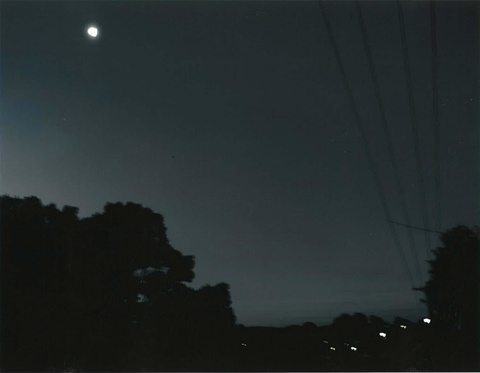
Artist Information:
Peter Annand
Commemorating:
Mayid Naser Husien Al-Ma'amoori: Professor of Veterinary Science at University of Baghdad. Assassinated 17 February 2007.
Artist Statement:
I chose to commemorate Professor Dr Al-Ma'amoori for this reason. When our son was a teenager he answered an advertisement to do gardening jobs for a retired professor of veterinary science who became a mentor to him then and an ongoing inspiration for his work now as a veterinary research scientist.
"Look at the moon", my grandfather wrote from the war in Europe to his family in Australia, and they back to him, "When it's on this side of the world I'll watch it and think of you".
I am humbled and privileged by the chance to offer this photograph. I have not been able to discover what age Dr Al-Ma'amoori reached, what was his specialty or how many students he inspired. Nor his personality, his delights and his regrets. Approaching my own 70th birthday I look at the moon above an Australian seaside town. I imagine its passage over his homeland and I think of his family and others who knew him and survived and are there or scattered elsewhere under the moon, perhaps describing him to a new generation.
Translation:
ملخص أكاديمي
ماجد ناصر حسين المعموري: استاذ بيطري في جامعة بغداد. اغتيل في ١٧ فبراير ٢٠٠٧.
تصريح الفنان
السبب الذي اخترت إحياء ذكرى الأستاذ الدكتور المعموري لأجله: عندما كان ابننا في سن المراهقة أجاب على إعلان للقيام بوظائف البستنة لأستاذ متقاعد في العلوم البيطرية أصبح معلمًا له في ذلك الوقت وإلهامًا مستمرًا لعمله الحالي عالم أبحاث بيطرياً.
كتب جدي من الحرب في أوروبا إلى عائلته في استراليا :"انظروا إلى القمر"، فأجابوه: "عندما يكون في هذا الجانب من العالم سأشاهده، وأفكر فيك".
ويسعدني ويشرفني إتاحة الفرصة لي لعرض هذه الصورة. لم أستطع معرفة العمر الذي بلغه الدكتور المعموري، وما هو تخصصه أو عدد الطلاب الذين ألهمهم، ولا شخصيته ونعيمه وندمه. مع اقتراب عيد ميلادي السبعين أنظر إلى القمر فوق بلدة ساحلية أسترالية، وأتخيل مروره فوق وطن الدكتور المعموري، وأفكر في عائلته وآخرين ممن عرفوه، ونجوا، وهم هناك أو مشتتون في مكان آخر تحت القمر يصفون الدكتور المعموري للجيل الجديد .
بيتر أناند ، أستراليا
#30 Mohammed Abdallah al-Rawi
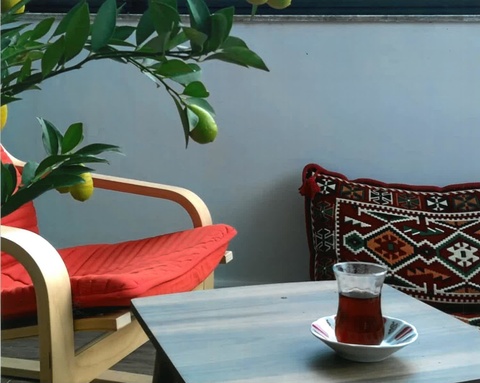
Artist Information:
Jessica Belt Saem Eldahr - USA/Turkey
"No Iraqi Home Without"
Commemorating:
Mohammed Abdallah Al-Rawi PhD: Surgeon, former president of Baghdad University, member of the
Arab Council of Medicine and of the Iraqi Council of Medicine, president of the Iraqi Union of Doctors.
Killed July 27, 2003.
Artist Statement:
“Tea has entered into the joints of her life, as it is like bread and there is no home without it.” - Iraqi
proverb
I too am a tea drinker, which is a good thing living in Turkey and having so many Iraqi friends and
colleagues. Iraqis are great drinkers of black tea, a heavy brew with lots of sugar and often flavored with
cardamom and served in an ‘Istikan’. They use similar cups here in Turkey, often served on beautifully
decorated saucers.
I sat down with my tea and the list of 324 slain Iraqi academics and quickly became overwhelmed. How
was I to pick a name? How is it possible that so many remain unknown? Even more overwhelming to me
was the much longer list of surviving loved ones who suffer the absence of their loved ones every single
day. There are no ‘unknown lost’ to them. The lost remain like whispers on their lips as they drink their
tea.
As I read through the list I recognized a name- Dr. Mohammed Abdallah Al-Rawi.
Weeks earlier my colleague and friend Dr. Azar Maluki was sharing his feelings about the invasion of
Iraq. During our conversation he shared the moment he knew that “dark times were ahead” - when he
heard of the death of a doctor, a teacher of his, and the president of the Iraqi Union of Doctors- Dr.
Mohammed Abdallah al-Rawi. He explained that Dr. Al-Rawi’s death stood out to him and his colleagues
as the turning point in the war with the start of the targeted assassinations of Iraq’s intellectual and
professional class.
What I know from my colleague and online research, Dr. Al-Rawi was an incredibly talented and
accomplished doctor, professor, administrator, and leader in the Iraqi medical field. He was married with
three sons. He dedicated his life to the medical profession, supporting fellow doctors, and raising up the
next generation of medical professionals. The many respected positions he held were a reflection of his
excellence in his field rather than any political connections.
Unfortunately, his name was on another list that marked academics for assassination after the US-led
occupation of Iraq. His wife Bushra later said that his response to the list was “...that he had no enemies. I
am a scientist and a doctor”.
What I also know from my research is that Dr. Al-Rawi was killed in his own clinic on July 27, 2003.
Two men entered his clinic, one doubled over in severe stomach pain, concealing a gun. He shot Al-Rawi
in front of his wife, Bushra, and patients. Their sons were only 22, 17, and 15 at the time.
I know his blessed memory lives on through his wife Bushra, their sons, and the many people his life
touched, including his students, like my friend Dr. Azar, and now through this project. I can’t say that it
feels like anything tangible, but I too whispered his name as I drank my tea today.
A life lost and remembered - there is no Iraqi home without.
Translation:
محمد عبدالله الراوي. دكتوراه في الجراحة، ورئيس سابق لجامعة بغداد، وعضو في المجلس العربي للطب والمجلس العراقي للطب، ورئيس الاتحاد العراقي للأطباء. قتل في 7 يوليو، 2003.
لا يخلو منه بيت
جيسيكا بيلت صايم الدهر
الولايات المتحدة الأمريكية، مقيمة في تركيا
"دخل الشاي في مفاصل حياتها، فهو كالخبز لا يخلو منه بيت" (مقولة عراقية).
أنا أيضًا أحب شرب الشاي. وهذا أمر جيّد لشخص يعيش في تركيا محاطاً بالكثير من الأصدقاء والزملاء العراقيين. العراقيون يحبون شرب الشاي الأسود مع الكثير من السكّر، وغالبًا بنكهة الهيل، ويقدمونه في "الاستكانة". هذه الأخيرة تشبه الأكواب المستخدمة هنا في تركيا التي تقدّم غالبًا على صحون الفناجين المزيّنة.
جلست أشرب الشاي، وأقرأ قائمة الثلاثمئة وأربعة وعشرين أكاديميًا عراقيا اغتيلوا، فغمرني الارتباك بسرعة. كيف يمكنني أن أختار اسمًا من بين كل هؤلاء؟ كيف يمكن للكثير منهم أن يبقوا مجهولي الهوية؟ وما أشْعرني بالقلق أكثر من هذا كله هو قائمة الفاقدين الأطول من هذه، أولئك الذين يتجرعون مرّ غياب أحبتهم في كل يوم. لا يوجد شيء اسمه "مجهول الهوية أو غير معروف" لهؤلاء، لأن الفقد باقٍ كهمسات على شفاههم كلما همّوا بشرب الشاي.
وأنا أقرأ الأسماء لفتني اسم الدكتور محمد عبدالله الراوي.
قبل أسابيع مضت شاركني الصديق والزميل الدكتور عازار مالوكي مشاعره حول غزو العراق. خلال محادثتنا شاركني اللحظة التي شعر فيها بأن أيامًا حالكة تنتظر العراق، وذلك حين سمع بمقتل طبيب، ومعلّم له، ورئيس الاتحاد العراقي للأطباء، الدكتور محمد عبدالله الراوي. شرح لي بأن مقتل الدكتور الراوي شكّل له ولأصدقائه نقطة تحوّل في الحرب، مع بداية استهداف العراقيين المفكرين و الاحترافيين.
من خلال ما عرفته عنه عن طريق زميلي، والبحث الذي قمت به على الإنترنت ، وجدت أن د. الراوي كان طبيبًا مبدعًا ومتفوقًا في عمله، وأستاذًا ومديرًا وقائدًا في مجال الطب. كان متزوجًا وله ثلاثة أبناء. كرّس حياته لمهنة الطب، وشجّع زملاءه الأطباء وأنشأ جيلًا مقبلًا من الأطباء. والمناصب المحترمة كلها التي شغلها دليلٌ على براعته في مجاله، من غير وساطات سياسية.
من المؤسف أن اسمه كان على قائمة أخرى تضم أسماء أكاديميين مستهدفين للقتل بعد الغزو الأمريكي للعراق. تقول زوجته، بشرى، إن ردّه على هذه القائمة كان قوله: "لا أعداء لي، أنا عالم وطبيب فحسب".
مما عرفت من خلال بحثي أيضًا أن د. الراوي قُتلَ في عيادته في 27 يوليو عام 2003. دخل رجلان عيادته، شكا أحدهم من ألم حادّ في المعدة، وكان قد أخفى مسدسه، ثم أشهره وأطلق النار عليه أمام زوجته بشرى، والمرضى هناك. آنذاك كان عمر ولده الأكبر 22 سنة وعمر الأوسط 17 وعمر الأصغر 15 سنة.
أعرف أن ذاكرته تحيا الآن من خلال زوجته بشرى، وأولاده، والكثيرين ممن أثرت فيهم حياته بما فيهم طلبته، مثل صديقي د. عزار. ومن خلال هذا المشروع أيضًا. أنا أيضًا أهمس اسمهُ اليوم وأنا أشرب الشاي، حتى إن لم يكن لذلك أثر ملموس.
لا يخلو بيت في العراق من فقيد مات، وما زال حيّاً في الذاكرة.
#37 Raad Shlash

Artist Information:
Bert Menco – The Netherlands/USA
“Harvest”
inkjet printing on matte photo paper; color and sepia tint version
8 x 10 inches
Commemorating:
Academic #37, Raad Shlash, PhD in Biological Sciences, Head of Department of Biology at Baghdad University‘s College of Sciences. Date of death unknown.
Artist Statement:
For this project it was important for me to honor a professional that I can relate to work-wise, therefore I selected biologist, Raad Shlash, PhD in Biological Sciences, Head of Department of Biology at Baghdad University‘s College of Sciences. Unfortunately, I was unable to determine his area of research, but as a biologist and human being, I hope that he would have appreciated the manner in which I approached his life and tragic death. Dr. Shlash was killed at the front door of his house on November 17, 2005. I honor him through a photograph I made on my patio (a small back yard) of my apartment in Evanston, IL, USA on the afternoon of March 25, 2022. The image I call “Harvest”.
Special about the photo is that it shows a, coincidental, true interspecies collaboration. For some reason, in our area grey tree-squirrels “harvested” leaves from our neighbor's vine, depositing these in my little yard. What could be the reason for this? I have been supplementing food for them, as well as birds through the winter. Did the squirrels want to return the favor by cutting down the leaves of the vine hanging over my fence and depositing these neatly over my grounds, also their grounds of course? The interaction, them depositing these leaves and me photographing the leaves reflects a powerful symbol of interspecies collaboration. Of course, I realize that I anthropomorphize, but nevertheless, I like the thought of these squirrels genuinely showing a token of friendship.
Like Dr. Shlash, I was a biologist for much of my professional life, but unlike him I had the good fortune to finish my career alive allowing me to have a full life after that. For that reason, it was very important to me to choose a peer, a biologist, who sadly lost his life for his profession and for being an academic. The 'interspecies' interaction depicted in my photograph reflects life in all of its beautiful forms, i.e., “Harvest” symbolizes destruction followed by construction through interspecies interactions.
Translation:
صورة لتكريم الضحية:
#37 رعد شلش، دكتوراه في العلوم البيولوجية، رئيس قسم البيولوجيا في جامعة بغداد، كلية العلوم. تاريخ الوفاة غير معروف.
بالنسبة لهذا المشروع، كان من المهم بالنسبة لي أن أخلّد ذكرى مهنيّ يشاركني في الاختصاص، ولذلك اخترت العالم البيولوجي رعد شلش، الحاصل على الدكتوراه في العلوم البيولوجية، ورئيس قسم البيولوجيا في كلية العلوم بجامعة بغداد. للأسف لم أتمكن من معرفة مجاله البحثي تحديدًا، ولكن كبيولوجي، وكإنسان أيضًا أتمنى أنه كان سيقدّر طريقة تكريمي لحياته ووفاته المفجعة. قتل الدكتور شلش أمام باب بيته في ال17 من نوفمبر، 2005. أحاول تكريم ذكراه بصورة فوتوغرافية صممتها في فناء شقتي في ايفانستون، الينوي، الولايات المتحدة الأمريكية، في ظهيرة يوم ال25 من مارس، 2022 وأسميتها: "حصاد".
المميّز في هذه الصورة أنها تمثّل نموذجًا عفوياً "للتعاون ما بين الأنواع الحيّة". في منطقتنا، "حصدت" السناجب الرمادية أوراق شجر من كرمة جارنا، وقاموا بدفنها في حديقة منزلنا. ما عساه أن يكون السبب في ذلك؟ أنا أوفر لهم الطعام باستمرار، وللطيور أيضًا خلال الشتاء. هل أراد السناجب أن يردّوا لي المعروف بقطع الأوراق من الكرمة المتدلية على سور منزلي، ووضعها بعناية على أرضي والتي هي بالطبع أرضهم أيضًا؟ هذا التواصل بيني وبينهم. هم يضعون الأوراق بينما ألتقط أنا صورة لها. يعكس هذا نموذجًا للتعاون ما بين الأنواع الحيّة. بالتأكيد، أنا واعٍ لتشخيصي للسناجب بتشبيهي هذا، ولكن، أحببت فكرة أن السناجب كانت تعبّر لي عن صداقتها وعرفانها.
مثل الدكتور شلش، كنت بيولوجيًا أغلب حياتي المهنية، ولكن على اختلاف منه، كان لي حظ جيد لأن أنهي مسيرتي المهنية وأنا حيّ، وأن يكون لي حياة بعد ذلك. لهذا السبب، كان من المهم بالنسبة لي أن أختار زميلًا بيولوجيًا أيضًا، فقد حياته بكل أسف بسبب مهنته ومجاله الأكاديميّ. هذا التواصل ما بين الأنواع الحية والذي أجسّده في التقاطتي، يعكس الحياة بكافّة أشكالها الجميلة، كمثال على ذلك؛ "حصاد" ، والتي تمثّل دمار يتبعه إعمار ناتج عن التعاون ما بين الأنواع الحية.
بيرت مينكو - هولندا \ الولايات المتحدة الأمريكية
العنوان: "حصاد"
#38 Rafi Sarcisan Vancan
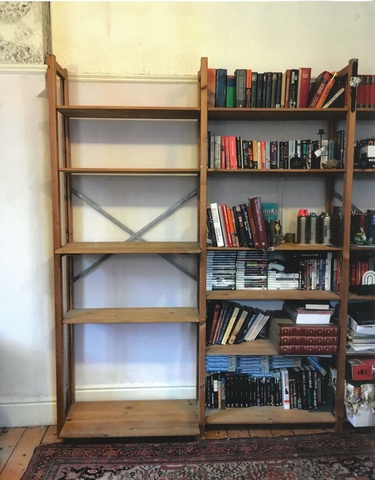
Artist Information:
Anahid Kassabian
Commemorating:
Rafi Sarcisan Vancan: Bachelor of English language, lecturer at Baghdad University's College of Women's Studies. Assassinated June 9, 2003.
Artist Statement:
Reading the list of murdered academics was very painful. As a former academic myself, I couldn't help but 'see' all the future students, and students of students, who were denied the light of these people's thoughts and insights, but also their tutelage. [Teaching is such a fundamental part of a university lecturer's work, though we tend to forget it.]
The first aspect of the photo is, for me, the rug on the floor in front of the bookcase, which embodies my connection to these murder victims. Rugs are one of the many areas of overlap between Armenian and Iraqi cultures. But the murdered person I chose is also Armenian, judging from his name—Rafi (a common Armenian man's name) Sarcisan (which is surely the surname Sarcissian/Sarkissian) Vancan. And it also touched me, as a lifelong feminist, that he was teaching at University of Baghdad's College of Women's Studies.
The empty bookcase carries several layers of meaning. To begin with, it lays bare the lost decades of reading and thinking that [the murdered scholar; Rafi Sarcisan Vancan] was denied. And then it makes visual all the scholarship, all the ideas, all the data, all the creativity that now cannot happen because their life was snuffed out prematurely. And finally, it displays all the work by students that they are not inspiring, encouraging, fostering, and commenting on, [since their murder, still today, and on into the future], because they are not here to do so.
As the empty bookcase demonstrates, the murder of an academic or artist does not just end their own life and thought, but also their participation in all of ours.
Translation:
رافي سارشيسان فانكان (#38)
الأكاديمي رافي سارشيسان فانكان: حاصل على البكالوريوس في اللغة الإنجليزية، محاضر في كلية دراسات المرأة في جامعة بغداد. قُتل في ال9 من يونيو 2003.
بيان الفنان
كانت قراءة قائمة الأكاديميين القتلى مؤلمة للغاية. بوصفي أكاديمية سابقة لا يسعني إلا أن أرى كيف حُرم جميع طلاب المستقبل، حتى طلاب هؤلاء الطلاب، من الفكر النيّر لهؤلاء الأكاديميين وبصيرتهم، وإرشادهم. [يعتبر التدريس جزءًا أساسياً من عمل المحاضر الجامعي، على الرغم من أننا نميل إلى نسيانه.]
الجانب الأول من الصورة الملتقطة، لي، هو السجاد أمام خزانة الكتب، الذي يجسد علاقاتي بالضحايا هؤلاء. يُعدّ السجاد أحد المجالات المتقاطعة بين الثقافة العراقية والأرمنية. لكن الأكاديمي القتيل الذي اخترت أرمنيّ. نستطيع ملاحظة ذلك من اسمه، "رافي" وهو اسم أرمنيّ شائع و سارشيسان (وهو بالطبع اسم عائلة سركسيان) فانكان . أثّر فيّ أيضاً أنه محاضر في كلية دراسات المرأة، بوصفي ناشطة نسوية.
تحمل خزانة الكتب الفارغة عدة معاني. بدايةً يكشف فراغها عن خسارة عقود من القراءة والتفكير حُرم رافي سركسيان فانكان من أن يعاصرها. ومن ثم تعرض بشكل بصري خسارة كلّ المعرفة، وكلّ الأفكار والمعلومات والإبداع الذي نفتقده لأننا فقدنا هؤلاء الأكاديميين لأن حياتهم سلبت منهم مبكرًا جدًا. وأخيرًا تُبيّن هذه الخزانة الفارغة خسارة أعمال طلابهم الذين كانوا سيلهمونهم، ويعلّقون على أعمالهم، ويشجعونهم. ولكن منذ قتلهم لليوم، وإلى المستقبل، سيفقد طلابهم هذا الدعم بخسارتهم إياهم.
تُخبرنا خزانة الكتب الفارغة أن مقتل الأكاديمي أو الفنان لا ينهي حياته وفكره فحسب، بل يقطع أيضًا استمرار عطائه المؤثر في حياتنا جميعًا.
أناهيد كسبيان
#40 Sabri Mustafa al-Bayaty
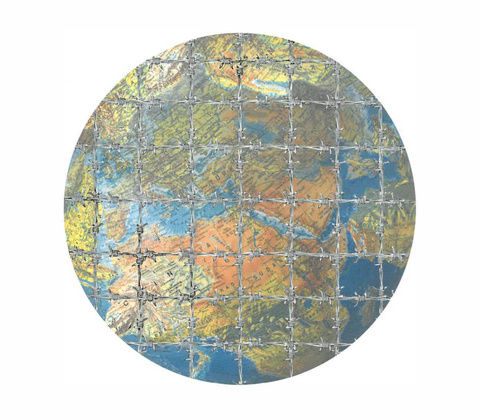
Artist Information:
Tania Baban – Iraq/USA
"The Geographic Divide"
inkjet printing on matte photo paper; color hand-tinting over image
8.5 x 11 inches
Commemorating:
Sabri Mustafa al-Bayaty, PhD in Geography. Lecturer, Baghdad University
College of Humanities. Killed June 13, 2004.
Artist Statement:
“Geographers explore both the physical properties of Earth’s surface and the human
societies spread across it.”
My image, The Geographic Divide, was created for Mr. al-Bayaty because of the importance of his field, which resonated with me. Our world geography keeps breathing new boundaries, creating new walls of concrete and barbed wire. Drawing blood-red lines in the sand. Keeping in, keeping out, all over our planet. Migrations and forced immigrations.
The image is taken of an actual globe that I shot from many different angles. I then manipulated them in Photoshop by creating another geography: cutting and pasting, overlapping parts of countries and continents every which way and randomly. I also added the barbed wire, which I hand-painted over the printed image. I wanted to emphasize the sometimes random movements of frontiers and the flux of the world, how it’s constantly in turmoil with forces that keep countries torn, divided, and in conflict. Forcing so many to leave homelands and families, abandoning ways of life they knew to seek shelters in other countries...to restart, re-assimilate in whatever country will take them; acquiring new languages and adapting to new climates just to protect their families.
It doesn’t matter where we’re from or where we live geographically—as human beings, we deserve to seek and live a life of safety and freedom. I think of Mr. al-Bayaty, an academic, a professor of geography. Who did he leave behind when his life was taken away from him? Did they end up fleeing Baghdad to seek refuge in another country, another geographic location. And I wonder if, when he left his house for the last time, he knew what geography lay ahead.
Translation:
الصورة الفوتوغرافية لتشريف الضحية:
#40 صبري مصطفى البياتي، حاصل على الدكتوراه في الجغرافيا. محاضر في كلية الإنسانيات في جامعة بغداد.. قتل في 13 يونيو 2004
"يستكشف الجغرافيون الخصائص الفيزيائية لسطح الكرة الأرضية والمجتمعات الانسانية المنتشرة عليها."
الصورة التي التقطتها المعنونة بـ"الانقسام الجغرافي" هي من أجل الأستاذ البياتي، وذلك لأهمية حقل اختصاصه الذي أثر فيّ. جغرافيا عالمنا اليوم لا تزال تتنفس الحدود التي ترسمها، وتخلق الجدران الإسمنتية والأسلاك الشائكة. ترسم الخطوط بالدم الأحمر على الرمال. تبقي بعضاً في الداخل وتقصي البعض الآخر للخارج. عبر كوكبنا تحدث الهجرات والهجرات القسرية.
التقطت هذه الصورة لمجسم للكرة الأرضية. التقطت صورًا له من عدة زوايا. ثم عالجت الصور بالفوتوشوب لأخلق جغرافيا جديدة: أقص وألصق أجزاء متشابكة من الدول والقارات بأشكال مختلفة وعشوائية. وأضفت الأسلاك الشائكة التي صبغتها يدوياً إلى الصورة المطبوعة. أردت التركيز على أن الحركات العشوائية للحدود والتحول المستمر في العالم في اضطراب دائم مع القوى التي تجعل الدول ممزقة ومنقسمة وفي صراع دائم. يجبر ذلك الكثيرين على ترك أوطانهم وعوائلهم، ويجبرهم على هجرة أنماط حياتهم للبحث عن مأوى في دول أخرى، للبداية من جديد، لإعادة استيعاب ذواتهم في كل مكان ستأخذهم الأقدار إليه، لكسب لغات جديدة والاعتياد على أجواء جديدة لحماية عوائلهم فحسب.
لا يهم من أين جئنا، ولا في أي موقع جغرافي نسكن الآن. نحن، البشر، نستحق أن نبحث عن حياة حرة وآمنة. أفكر في الأستاذ البياتي، الأكاديمي، وأستاذ الجغرافيا. مَنْ خلّف وراءه عندما سُرقت حياته منه؟ ماذا حصل لهم؟ هل انتهى بهم الأمر إلى ترك بغداد والبحث عن ملجأ في دولة أخرى؟ وأتساءل: هل كان يعرف ما تخبئه الجغرافيا له عندما ترك بيته، آخر مرة؟؟
تانيا بابان - العراق \ الولايات المتحدة
العنوان: الانقسام الجغرافي
#67 Isam al-Raui
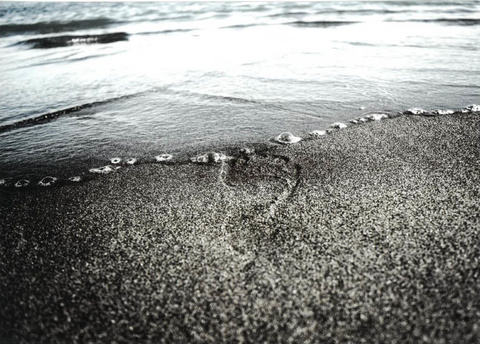
Artist Information:
Ivo Mandrile – Argentina
Commemorating:
Isam Al-Raui: Geology PhD, professor at Baghdad University and President of the Association of University Professors of Iraq. Murdered on October 30th of 2006 in an assault performed by armed men, in which two other professors were injured.
Artist Statement:
YOU ARE GONE
TO THE GREY OCEAN
AND THE WAVES
AND THE TIME
WILL ERODE
BUT WILL NOT DELETE
YOUR TRACE IN THE SAND
Translation:
العنوان: طبع على الرمل
التاريخ: 2019
تكريمًا لـ:
#67 عصام الراوي : دكتوراه في الجيولوجيا، أستاذ في جامعة بغداد ورئيس جمعية أساتذة الجامعات في العراق. قتل في ال30 من أكتوبر عام 2006 في عملية انتهاك نفّذها رجال مسلّحون ، وأصيب فيها أسْتاذانِ بجراحٍ أيضاً.
البيان:
غبتَ
في المحيط الرماديّ
غدًا.. سَتتآكل الأمواج
سَيتآكل الوقت
ولكن لن يغيب
أثرك على الرمال
ايفو ماندريل - الأرجنتين
#71 Jassim al-Assadi
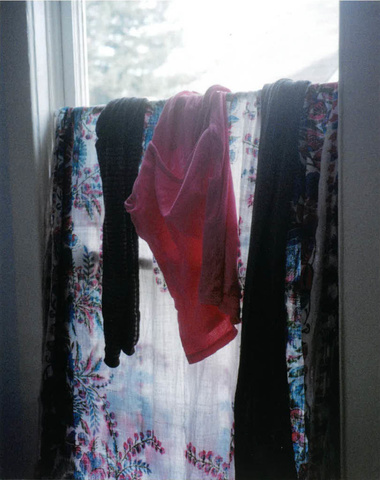
Artist Information:
Summer Brenner - USA
digital chromogenic
Commemorating:
Jassim al-Assadi's wife, a Lecturer at the College of Administration and Economy at Baghdad University, died October 2, 2006.
Artist Statement:
WITHIN ... WITHOUT
When she wakes, she can see the color of the day. Clouds. The rising moon. Stars. Through the window is the future.
On her side of the glass is the past. A room filled with books she once read, odors of cardamon and kebab she cooked yesterday, photos of loved ones, alive and dead.
Maybe it's obvious from the curtain. A woman lives in this room. It's not made to be a curtain but a simple piece of beautiful cloth. Perhaps found in the market. Or given to her as a gift from an aunt or grandmother.
Sometimes she uses the curtain rod as a clothesline where she hangs stockings or a blouse to dry against the glass.
The curtain covers the window's lower half so she can hide from the outside. But the upper half is open to the sky that reveals what is beyond the Earth. Beyond war. Beyond even herself.
We don't know her name. So much of the history of women has been nameless.
She appears as "Jassim al-Assadi's wife (name unknown)" on the List of Iraqi academics assassinated in Iraq during the US-led occupation.
On the list of 324, she is #71.
All we know is she was Jassim al-Assadi's wife, a Lecturer at the College of Administration and Economy at Baghdad University. The date of death associated with #71 is October 2, 2006. Mohammed Jassim al-Assadi, Professor and Dean of the College of Administration and Economy at Baghdad University appears in the list as #70, killed in a targeted attack with a son.
Days, months, years, over a decade has passed, but the living remember. Perhaps family and friends think of her on her birthday and the anniversary of her death. Maybe one of them has her scarf or a vase. Maybe another the photos of her son as a baby. Her name is passed among them. A name we don't know.
Yet we too remember her.
Translation:
داخلًا .. من دونها
عند استيقاظها، ترى الغيوم. بزوغ القمر، والنجوم. عبر النافذة يقف المستقبل.
خلف الزجاج، حيث كانت، يقبع الماضي. غرفة مليئة بكتب قرأتها يومًا، ورائحة الهيل والكباب الذي طهته البارحة، وصور أحبتها الأحياء منهم والأموات.
قد يبدو واضحًا من الستار أن امرأة تعيش في هذه الغرفة. هذه الستارة لم تكن ستارًا في الأصل، هي قطعة جميلة من الملابس، ربما وجدتها في السوق، أو أهدتها خالتها أو جدتها إياها.
أحيانًا تستخدم عمود الستارة حمّالة للملابس تعلّق عليها جواربها أو قميصها لينشف بالقرب من زجاج النافذة.
تغطّي الستارة الجزء السفلي من النافذة لتحجبها عن الخارج، وتكشف عن الجزء الأعلى منها لتُظهر السماء. لتبيّن ما هو أبعد من الأرض والحرب، وما هو أبعد منها هي أيضًا.
لا نعرف لها اسماً مثلما لا نعرف أسماء الكثير من النساء في التاريخ.
على قائمة الأكاديميين العراقيين القتلى في العراق خلال الاحتلال الأمريكي تُعرف بـ"زوجة جاسم الأسعدي" - (الاسم غير معروف).
على القائمة ذات ال324 اسمًا، تحتل الرقم #71
كل ما نعرفه أنها زوجة جاسم الأسعدي، محاضرة في كلية الإدارة والاقتصاد في جامعة بغداد. تاريخ الوفاة المرتبط بالشخص رقم #71 هو 2 أكتوبر، 2006. محمد جاسم الأسعدي هو أيضًا أستاذ وعميد لكلية الإدارة والاقتصاد في جامعة بغداد يظهر اسمه في الرقم #70 على القائمة، وقد قتل بهجوم استهدفه وابنه.
مرت الأيام والشهور والسنين. مرّ أكثر من عقد، ولكن ذكراها باقية في أذهان الأحياء. على الأرجح إن عائلتها وأصدقائها يفكرون بها في يوم عيد ميلادها، وفي ذكرى وفاتها. قد يملك أحد منهم شالًا لها، أو مزهرية، أو صوراً لابنها وهو ما يزال طفلًا. يمرّ اسمها بينهم، اسمها الذي لا نعرف، ولكننا أيضًا نحفظ ذكراها.
عنوان الطباعة: داخلًا.. من دونها
#76 Majed Nasser Hussain
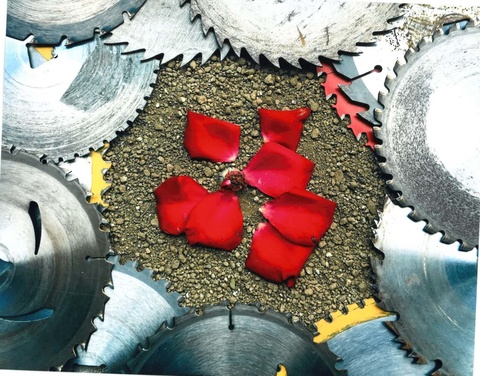
Artist Information:
David Ginsberg
Commemorating:
Majed Nasser Hussain: PHD and lecturer at the College of Veterinary Medicine, Baghdad University. He was killed in front of his wife and daughter while leaving home in the third week of January 2007. Nasser Hussain had been kidnapped two years before and freed after paying a ransom.
Artist Statement:
I am haunted by the brief information concerning Majed Nasser Hussain's violent death. He had been a man of medicine, one who taught others how to treat and ameliorate the pain and suffering of animals. I can imagine the duress and trauma for him and his family when he is kidnapped 2 years earlier, his fate unclear until his ransom is paid. Was he kidnapped for money only or for political reasons? Did he and his family live in dread everyday thereafter? We only know that he was coldly slaughtered in front of his wife and daughter while leaving the supposed safety and sanctuary of their home.
I felt the sense of the cold-hearted brutality of his assassination and wished to portray that sense in the image. I thought of the massive power of these hard steel saw blades which can easily cut through and sever dense wood. Used as weapons they remind me of overbearing malevolence and savagery. They surround and encroach upon a torn flower. The flower, representing the life of Mr. Hussain as well as his family, has lived and bloomed and brought the world beauty and pleasure. Its fragility and ephemeral nature is no match for the blades. It has been torn asunder.
Translation:
ماجد ناصر حسين: حاصل على الدكتوراه في كلية الطب البيطري بجامعة بغداد. قتل أمام زوجته وابنته بينما كان يغادر المنزل في الأسبوع الثالث من يناير عام 2007. اختُطف ناصر حسين قبل ذلك بسنتين، وحُرّر بعد دفعه للفدية.
تطاردني المعلومات القليلة حول موت ماجد ناصر حسين العنيف. كان رجل طب، علّم الآخرين علاج الألم ورفعه عن الحيوانات التي كانت تعاني. أستطيع تصوّر الصدمة التي أصابته وعائلته عندما اختطف قبل سنتين من ذلك الوقت، وكان مصيره مجهولاً إلى أن دُفعت الفدية. ما كان سبب اختطافه يا ترى؟ أ كان المال الدافع الوحيد أم كانت هناك أسباب سياسية؟ هل كانت عائلته تعيش في فزع دائم بعد تلك الحادثة؟ لا نعرف شيئًا سوى أنه نُحر بدم بارد أمام زوجته وابنته، بينما كان يهمّ بترك منزله، المكان الذي يفترض أن يجد فيه الملجأ والأمان.
أحسست بفظاعة قتله بدم بارد، وأردت أن أصوّر ذلك في الصورة التي أقدمها. كنت أفكر بأسنان المنشار الحادة، وقدرتها العظيمة على قطع حتى الأخشاب الصلبة. استخدام المناشير كأسلحة يذكرني بالهمجية والاستبداد. الهمجية التي تحاصر وتنتهك وتمزّق وردة. هذه الوردة تمثّل حياة الأستاذ حسين وعائلته أيضًا، في تفتّحها الذي أضاء للعالم الجمال والسرور. وفي رقّتها وطبيعتها سريعة الزوال التي لا تضاهي أسنان المنشار الحادة والقوية، تلك التي قطّعت الوردة إربًا إربًا.
ديفيد جينسبيرغ
#81 Nihad Mohammed al-Rawi
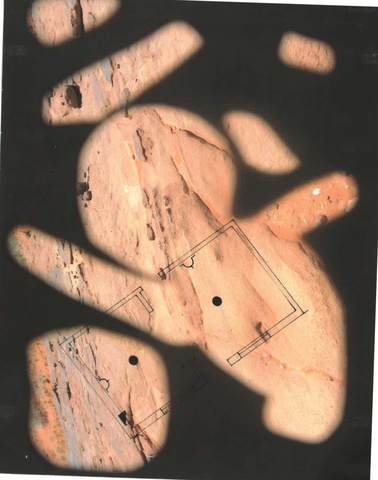
Artist Information:
Cecilia Mandrile – Argentina
Commemorating:
Nihad Mohammed al-Rawi: Professor of Civil Engineering and deputy president of Baghdad University. Shot dead 26 June 2007 in al-al-Jadria Bridge, a few meters away from the university campus, when exiting with his daughter Rana, whom he protected from the shots with his body. (Sources: Brussells Tribunal and CEOSI Iraqi university sources, 26-27 June 2007 )
Artist Statement:
Betweening (OneOther)
In the language of animation, to tween means to have a change made between two
objects. In this way, moving, morphing, transforming, One becomes OneOther. Following this concept, Betweening, a traveling and practice-based research, focuses in the sense of incompleteness experienced along transition processes.
Betweening, emerges as a response to my recent experience living and working in Middle East as a traveling South American woman artist, and through this, a continuation on my rehearsing of visual translations of displacement. Based in the ‘payada’, word battle practiced between nomadic oral poets, both in South America and in the Arab World, I intend to articulate the motivations and intentions of a form of communication that is established between two other-nesses in a space of blurred frontiers, where the nomads are forced to settle, and settled ones, to become nomads.
Unveiling intersections between nomadic practices within different cultures, Betweening proposes a dialogue conceptually based in the improvised poetic encounters among both Bedouins and Gauchos (the vanishing nomadic cattle herder of the Pampas). Shaped by the social mistrust towards wanderers, solitary nomads embark on their own ‘poetic battle’: when moving may become the deepest form of entrapment.
OneOther (To Nihad & Rana)
In homage to #81 Nihad Mohammed al-Rawi
In the context of Betweening, I developed this image for Al Mutanabi Street Starts Here´ Shadows & Light exhibition, in honor to Nihad Mohammed Al-Rawi and his surviving daughter Rana.
Nihad, like my father, was a Civil Engineering, and a professor and deputy president of Baghdad University. He was shot dead on 26 June, 2007 in al- Jadria Bridge, a few meters away from the university campus when leaving with his daughter Rana. Transforming his body into a fortress, in his wise constructive instinct, he protected and saved her.
This portrait, developed for Al Mutanabi Street Starts Here´ Shadows & Light exhibition
was taken in Wadi Rum in Jordan. Observing the desert through an absent body, loud emptiness searches for a dialogue with lines that sketch two rooms with a heart. Through connecting rescued fragments from one of my father’s architectural drawing and the light seeing through the shadows; displacing, shielding, reconstructing,
I rehearse this homage to Nihad and Rana, the translation of a wound.
Translation:
نهاد محمد الراوي: أستاذ هندسة معمارية ونائب رئيس جامعة بغداد. اغتيل برصاصة في ال26 من يونيو 2007 على جسر الجادرية، والذي يبعد عن حرم الجامعة بضعة أمتار، بينما كان مغادرًا الجامعة مع ابنته رنا التي حماها من الرصاص بجسده. (المصادر: محكمة بروسلز ومصادر من الجامعات العراقية، 26-27 يونيو 2007)
البَيْنيّة ، الواحد الآخر
في فنّ الرسوم المتحرّكة، يعني الفعل "tween" إجراء تغيير بين شيئين. بهذه الطريقة من الحركة والتحوّل يفقد الشيء ماهيته من دون أن يصبح شيئا آخر، بل شيء بينيّ، لا هذا ولا ذاك . باتّباع هذا المفهوم يصبح جوهرمنهج البحث العلمي القائم على البينية والانتقال والممارسة هو عدم الاكتمال الذي نجرّبه في أثناء العمليات الانتقالية.
هذه "البينية" كانت استجابة لتجربتي العمل مؤخراً في الشرق الأوسط فنانة أمريكية جنوبية متنقلة، وهي، من خلال ذلك، استمرار في التمرين على ترجمة النزوح لأعمال مرئية. أسعى للتعبيرعن الدوافع والنوايا التي تدفع البدو الرحّل لتطوير السجالات الشعرية أسلوب تواصل. أستلهم هذا من ال"Payada" في أمريكا الجنوبية، وفي العالم العربي أيضًا، حيث تشتهر المناظرات الشفهية بين الشعراء البدو. أعتزم فهم هذا الأسلوب من التواصل المؤسس بين طرفين غير مكتملي الماهية، في مساحة غير واضحة الحدود، حيث يجبر البدو على الاستقرار، ويجبر المستقرون على أن يكونوا بدوًا مترحلين.
كاشفة عن التقاطعات الثقافية للعادات البدوية في ثقافات مختلفة تقترح "البينية" حوارًا مفاهيمياً على أساس التجارب الشعرية المرتجلة عند كل من البدو والغاوتشو (وهم رعاة المواشي البدو في بامبس).
يدفع عدم الثقة تجاه المترحلين البدو المنفردين إلى معاركهم الشعرية الخاصة، حيث التنقّل هو أعمق شكل من أشكال الخطر.
الواحد الآخر (إلى نهاد ورنا)
إهداء إلى نهاد محمد الراوي #81
في سياق هذه "البنية" صوّرت هذه الصورة ضمن مشروع "شارع المتنبي يبدأ من هنا"، معرض الضوء والظل، تكريمًا لنهاد محمد الراوي، وابنته الناجية من الموت.
نهاد كان كوالدي مهندسًا مدنيًا، ونائب رئيس جامعة بغداد. قُتل نهاد مرميًا بالرصاص بينما كان يهمّ بمغادرة الحرم الجامعي مع ابنته رنا. بفطرته البنّاءة حوّل جسده درعاً حصيناً حماها وأنقذها من الموت.
التقطت هذه الصورة في وادي رم في الأردن، لأشارك في "شارع المتنبي يبدأ من هنا"، معرض الضوء والظل.
مطلاً على الصحراء من خلال جسد غائب يبحث الفراغ الصاخب عن حوار مع خطوط ترسم غرفتين بقلب واحد. بربط الأجزاء التي أُنقَذت من رسم معماري لوالدي، ورؤية الضوء من خلال الظلال، والنزوح، والاحتماء بالدروع، وإعادة البناء، أتدرب على تكريم نهاد ورنا، وأترجم جرحهما صورة مرئية.
سيسيليا ماندريل - الأرجنتين
#89 Mudhafar Mahmoud
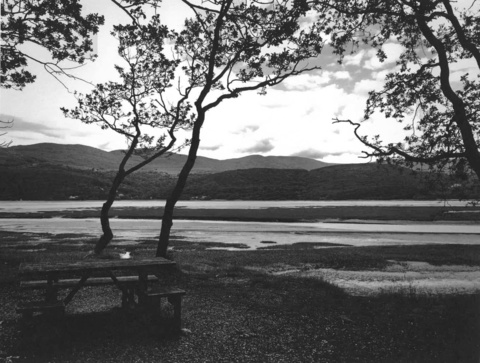
Artist Information:
Zoe Lafferty - UK
Commemorating:
Mudhafar Mahmoud: associate professor in the Geology Department in the College of Science, University of Baghdad. Dr Mahmoud was assassinated on 28 November 2010 near his house in Baghdad. [Source: Iraqi source to BRussells Tribunal on 1st December, 2010.]
Artist Statement:
Taken in the heart of Snowdonia National Park, Wales, UK. The geological story of Snowdonia, as told by the rocks that make up its hillsides and valleys, spans over 625 million years. The National Park aims are to
conserve and enhance the natural beauty, wildlife and cultural heritage of the area; promote opportunities to understand and enjoy its special qualities; and to foster the economic and social well-being of its communities.
It is estimated that in less than forty years this area photographed will be completely flooded due to Climate Change.
Translation:
. مظفر محمود: أستاذ مساعد في قسم الجيولوجيا في كلية العلوم في جامعة بغداد. اغتيل الدكتور محمود في 28 تشرين الثاني (نوفمبر) 2010 بالقرب من منزله في بغداد. [المصدر: مصدر عراقي أمام محكمة براسلز في الأول من كانون الأول (ديسمبر) 2010.]
التُقطتْ في قلب حديقة سنودونيا الوطنية في ويلز، المملكة المتحدة. تمتد قصة سنودونيا الجيولوجية التي ترويها الصخور التي تشكل سفوح التلال والوديان على مدى 625 مليون سنة. تهدفُ الحديقة الوطنية إلى الحفاظ على الجمال الطبيعي والحياة البرية والتراث الثقافي للمنطقة. كما تهدف الحديقة لتعزيز فرص إدراك صفاتها الخاصة والاستمتاع بها بالإضافة إلى رعاية الرفاه الاقتصادي والاجتماعي لمجتمعاتها.
تشير التقديرات إلى أنه في أقل من أربعين عامًا ستغرق هذه المنطقة التي صُوَّرتْ كلها بسبب تغير المناخ.
زوي لافرتي - المملكة المتحدة
#114 Saad Mehdi Shalash
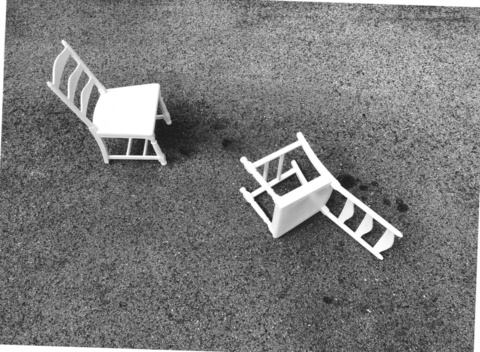
Artist Information:
Kent Manske – USA
Photograph. Pigment print on Entrada Rag Natural
14 x 11″ (36 x 28 cm)
Edition 7
Commemorating:
Saad Mehdi Shalash: PhD in history and lecturer in history at the College of Arts, al-Mustansiriya University, and editor of the newspaper Raya al-Arab. Shot dead at his home with his wife 26 October 2006. [Source: al-Quds al-Arabi, 27 October 2006].
Artist Statement:
I imagine a couple at the end of the work day. They sit in the garden talking quietly, sipping tea. They listen to the sounds of the neighborhood, and the birds chirping in a nearby orange tree. They may be sitting side by side, looking out over the same view, occasionally turning towards each other to connect with their eyes. Or maybe they sit across from each other, rubbing each other’s feet as they share the details of their days, discuss their concerns, reminisce and plan.
This was my entry point in thinking about Professor Saad Mehdi Shalash and his wife, shot dead at their home in Baghdad.
Targeted. Eliminated. An attempt to erase the influence that a teacher had on his students, the influence a newspaper editor had on his readers. History, knowledge and reason aren’t easily eradicated. The human desire to understand, grow and improve upon a given situation
is beyond the reach of ignorance and fundamentalism.
I shot about forty photographs with two chairs, one for Saad, one for his wife, in different configurations. Symbolically, two chairs indicate a place for connection and/or communication. Each two chair arrangement I made elicited a different narrative. Upon reviewing the photographs, the picture that resonated with me was one chair standing and one chair tipped over. When I look at this photo in the context of Saad and his wife’s vicious murder, I find myself trapped in the upright chair asking ”why“ with a visceral sorrow taking over my whole body. The photograph is a full-color image, shot from a ladder in an asphalt parking lot, with no photo manipulation. This cold hard backdrop comments on the harsh reality that violence against others is a solution for disagreement in today’s polarized world, often encouraged by leaders for political gain. It is the memory of Saad Mehdi Shalash and his unnamed wife, that will keep me vigilant as an activist for good.
Translation:
بيان الفنان
مشروع الضوء والظل الفوتوغرافي
أبعد منهم
#113 سعد مهدي شلاش: دكتوراه في التاريخ، ومحاضر في التاريخ في كلية الفنون في جامعة المنصورية، ومحرر جريدة راية العرب. قتل بالرصاص مع زوجته في بيته بتاريخ 26 أكتوبر 2006 (المصدر: القدس العربي، 27 أكتوبر 2006)
أتخيل زوجين في نهاية يوم عمل جالسين في الحديقة يتحدثان بهدوء، و يحتسيان الشاي. يستمعان لأصوات الحي والطيور المزقزقة على شجرة البرتقال القريبة. قد يكونا جالسين متجاورين ، ينظران للمشهد ذاته، و يلتفتان أحدهما إلى الآخر أحيانًا، وتلتقي عيناهما. وقد يكونا جالسين متقابلين تتلامس أقدامهما كلما تشاركا واحدًا من تفاصيل حياتهم. يتحدثان عن ما يقلقهما، وما يخططان له، وما يخالجهما من ذكريات.
كانت هذه نقطة البداية لتفكيري بالبروفيسور سعد مهدي شلاش وزوجته اللذين أرديا قتيلين في بيتهما في بغداد.
مستهدفين. مقصيين. كانت تلك محاولة لمحو الأثر الذي تركه هذا المعلم على تلاميذه، والمحرر على قرّاء الصحيفة. ليس من السهل محو التاريخ والمعرفة والمنطق. رغبة الإنسان في الفهم والنمو والتطور تجاه موقف ما لا يطالها التجاهل والتطرّف
التقطت ما يقارب 40 صورة لكرسيين بترتيبات مختلفة. كرسي لسعد والآخر لزوجته. يرمز الكرسيان إلى القرب والتواصل. في كل صورة كان ترتيب الكراسي يحمل سردية مختلفة. وأنا أعيد النظر في الصور لفتت انتباهي صورة كان أحد الكراسي فيها قائماً والآخر مقلوباً. عندما أنظر الى هذه الصورة، في سياق جريمة قتل سعد وزوجته، أجد نفسي حبيساً على الكرسي القائم أتساءل : "لماذا"؟؟ بحزن عميق يجتاح جسدي كله. التقطت هذه الصورة، الملونة بالكامل، من على درج في موقف سيارات، ولم أجر أي تعديلات على الصورة. هذه الخلفية الصلبة والباردة تعلّق على واقع عالمنا المستقطب اليوم، على واقع قاسٍ، العنف تجاه الآخرين فيه هو الحل للاختلاف، واقع يشجع عليه القادة السياسيون لمكاسبهم. ما سَيجعلني ناشط متيقظ للخير هي ذكرى سعد مهدي شلش وزوجته مجهولة الاسم .
#117 Najeeb (or Nadjat) al-Salihi
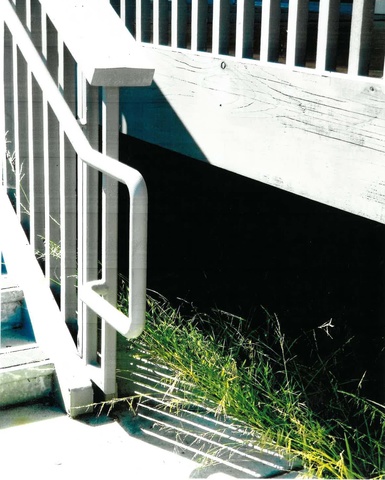
Artist Information:
Geneffa Popatia Jonker - USA
Cabrillo College, Santa Cruz CA.
July 24, 2020. Samsung phone/HP
Commemorating:
Najeeb [or NadjatJ al-Salihi: lecturer in the College of Psychology at al-Mustansiriya University and head of the Scientific Committee of the Ministry of Higher Education of Iraq. AI-Salihi, 39 years old, was kidnapped close to campus and his body, shot dead, was found 20 days after his disappearance in Baghdad morgue. His family was able to recover his body only after paying a significant amount of money, October 1, 2006. [Source: CEOSI Iraqi university sources].
Artist Statement:
Najeeb - I am reaching through the years to join and elongate the search for your body during those twenty days you were missing. A decade apart in age-I write this at 49 on the last day of my 401s, thinking of you poised at 39 with dreams of a decade you wouldn1t know. Your loved ones knew you were snatched close to campus, and I watch them comb the area, search under stairwells, scream at the foundations to say what happened.
I returned to my campus during a pandemic to look for you, Najeeb, and it was the dark recesses that called me. There's something haunted and liminal to me about a campus out of session, void of people. No longer distracted by those who congregate, my attention was drawn to what lies underneath-the stories stashed there out of sight, the lives snatched away before they arrive.
For twenty years I have climbed these stairs to the main office, but not until now have I stared into the void beneath it. I imagine it has not always been barren. If I stare long enough, I can imagine the day laborer who rested there on breaks while building a framework his children might someday enter. The person wandering campus seeking shelter when rain comes. The person waiting to be found.
I ask myself what lies outside our peripheral vision. Perhaps it would be something so valuable we immediately recognize it as our own-so valuable that we would pay significantly for its return.
I stand here longer and envision you looking out at me from the void. The railing creates a shadow with slats of light streaked through it, blades of grass spilling over it onto my path joining my walk with yours. A handrail thrusts toward me its reminder of assistance. I grasp
it with thankfulness and keep you with me. Together, we ascend.
Translation:
"عودة وصعود" جينيفا بوباشيا جونكر (الولايات المتحدة الأمريكية)
كلية كابريلو، سانتا كروز، كاليفورنيا. 24 يوليو، 2020. سامسونج\اج بي
117. نجدت الصالحي: محاضر في كلية علم النفس في جامعة المستنصرية، ورئيس اللجنة العلمية لوزارة التعليم العالي في العراق. الصالحي، بعمر ال39 سنة، اختطف بالقرب من مبنى الجامعة، قُتل، ووُجدَ جسده بعد عشرين يوم من اختفائه في مشرحة بغداد. لم تستطع عائلته استرجاع جثمانه إلا بعد دفعها لمبلغ من المال، 1 أكتوبر، 2006. (المصدر: CEOSI مصادر الجامعة العراقية).
أعبر السنين لأشارك في إطالة عملية البحث عن جسدك خلال هذه العشرين يومًا من غيابك يا نجيب. بعد مرور عقد أكتب هذه الكلمات، وأنا في ال49 من العمر، وأنا أختم الأربعينات من عمري. أفكر بك وقد توقف عمرك عند ال39 بأحلام عقد لم تشهده. عرف أحبتك أن هناك من اختطفك بالقرب من الجامعة. أراهم ينقبون في المنطقة، يبحثون تحت السلالم، يصرخون في المؤسسات يوثقون ما حدث.
عدت للجامعة خلال الجائحة بحثًا عنك، يا نجيب. كانت الظلمة الجوفاء تناديني. هناك شيء ما يطاردني تجاه جامعة معطّلة خالية من الناس. لم تعد حركة الجموع من الناس تشغلني. بات انتباهي منصبًا على القصص الخفيّة الغائبة عن النظر والحيوات التي خُطفت قبل أن يصل أصحابها إلى الجامعة.
عشرين سنة وأنا أصعد هذه السلالم للمكتب الرئيس، ولكني إلى الآن لا أستطيع التحديق في الفراغ تحتها. لم يكن المكان فارغًا كل هذا الفراغ من قبل. إذا حدقت فيها بشكل كافٍ استطعت تخيّل عاملٍ في أوقات راحته خلال عمله في بناء مبنىً قد يدخله أطفاله يومًا ما. أستطيع تخيّل شخصٍ يتجوّل في الجامعًا بحثًا عن مأوىً يحميه من المطر. أتخيّل شخصًا بانتظار العثور عليه.
أسأل نفسي عمّا هو أبعد من قدرتنا البصرية. من المؤكّد أنه شيءٌ غالي الثمن. شيءٌ نعرفه توّاً عندما نراه كما لو كان شيئاً من أشيائنا. . شيء ثمينٌ جدًا ندفع الغالي والنفيس لعودته.
أقف هنا طويلًا وأتخيلك تنظر إليّ من الفراغ. سور السلالم المُشبّك يخلق ظلًا تتخلّله بعض أعمدة النور. يشاركني العشب مسيرة البحث عنك. تندفع أسوار السلّم في يدي تذكّرني برغبتها في تقديم المساعدة. أمسك بها بكثير من الشكر والامتنان. و أحتفظ بك معي. معًا نصعد للأعلى.
#150 Sami Sitrak
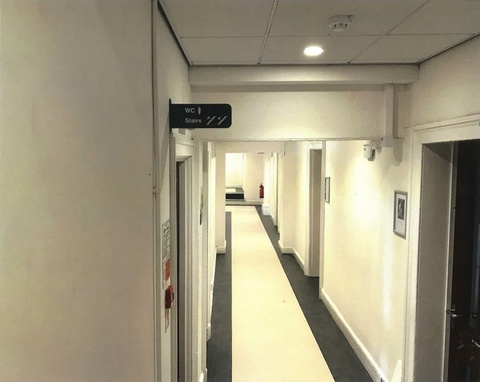
Artist Information:
Deryn Rees-Jones - UK
Commemorating:
Sami Sitrak: Professor of English and dean of al-Nahrein University‘s College of Law.
Professor Sitrak was killed 29 March 2007. He had been appointed dean of the College after the former dean‘s resignation following an attempt to kill him along with three other College lecturers. [Source: Iraqi Association of University Lecturers, April 7, 2007.]
Artist Statement:
Sami Sitrak was a linguist who wrote his PhD at the University of St Andrews, graduating the same year I would have been starting my own degree as an undergraduate in North Wales. I did not know him or anyone who knew him, although it is likely, given the smallness of the academic world, that there are people in both our lives who would have met. I imagine at some point we would have had shared experiences: of walking along the same streets in St Andrews, a place I know well: sitting at the same cafes, looking at the same views. Perhaps Professor Sitrak visited Liverpool, or had friends who studied here. There is a deep bond between academics, and our experiences as researchers and teachers, who are working every day with young people, run deep. Reading through the list of people who tragically lost their lives simply by being who they were (which I often have the privilege of taking for granted) is a deeply moving experience. It also reminds me that even though there are experiences that cannot always be fully explained or understood in language, the act of empathy and identification is always a transforming process.
The picture I have taken shows the corridor outside my office in the English department of the University of Liverpool where I have worked for the last seventeen years. Long and narrow, my office has a large window at its end, and from it I can look out on the university square; the gardens, in June as I am writing, are bright with flowers and leafy trees. My door, which opens onto the corridor in the photograph, has a glass panel. Seeing the comings and goings of students and of my colleagues as they pass by (and them, in turn seeing me, as I sit working at my desk) is a normal part of my day during term-time. Summer is a busy time for academics, as we are often finishing marking, attending exam boards before sending off our graduating students in July; but it is also a time when the university buildings can feel strangely quiet. Here the corridor, taken early one Monday morning, seems so ordinary, so generic. It feels like it could be any corridor in any university, with its bland signage and basic lighting. Its emptiness now makes me think deeply about how one person’s death changes so much for so many people. It also reminds me how many lives Professor Sitrak must have changed in so many positive ways. I would like also to celebrate that.
Translation:
سامي سيتراك: أستاذ في اللغة الانجليزية وعميد كلية الحقوق في جامعة النهرين.
قتل الأستاذ سيتراك في 29 مارس 2007. كان قد عُيّن عميدًا للكلية بعد استقالة العميد السابق إثر محاولة لقتله وثلاثة محاضرين آخرين. (المصدر: رابطة التدريسيين الجامعيين، 7 أبريل 2007.)
كان سامي سيتراك لغويًا. كتب رسالته للدكتوراه في جامعة سانت آندروز، وتخرّج في نفس السنة التي بدأت فيها دراستي في جامعة نورث ويلز. لم أكن أعرفه، ولا أعرف أحداً ممن يعرفونه، رغم أنه من المرجّح أننا نعرف أشخاصاً مشتركين بيننا حيث العالم الأكاديمي صغير جدًا. من الممكن جدًا أن تجاربنا أيضًا كانت مشتركة، من المشي على شارع سانت آندروز، المكان الذي أعرف جيّدًا، إلى ارتياد المقاهي ذاتها، ومشاهدة ذات المناظر. الغالب أن الأستاذ ستراك زار مدينة ليفربول، أو كان له أصدقاء هناك. هناك رابط عميق بيننا ك أكاديميين، وبين تجاربنا كباحثين ومعلمين يعملون كل يوم مع الشباب. كانت عملية قراءتي لقائمة أسماء من فقدوا حياتهم ببساطة بسبب هويتهم تجربة مؤثرة جدًا. حيث إنه امتياز أن يستطيع الإنسان أن يكون كما هو. يدفعني هذا للتفكير بالتجارب التي لا نستطيع شرحها أو فهمها بالكامل في لغة ما، فيصبح التعاطف معها وتحديدها عملية تحّول بحد ذاتها.
تبيّن الصورة التي التقطتها الممر خارج مكتبي في قسم اللغة الانجليزية في جامعة ليفربول، حيث كنت أعمل السبعة عشرعامًا الأخيرة. في نهاية مكتبي الطويل والضيق نافذة كبيرة تطل على ميدان الجامعة، حيث الحدائق وأزهارها البراقة وأشجارها المورقة في شهر يونيو، وقت كتابتي لهذه الكلمات. وباب مكتبي الزجاجي، الذي يطل على الممر في هذه الصورة، يمكّنني من رؤية الطلبة والأساتذة المارين، ويمكّنهم أيضًا من رؤيتي وأنا أعمل. كانت رؤيتي للمارين جزءاً من روتيني اليومي خلال الفصل الدراسي. خلال الصيف يكون الأساتذة منشغلين بتصحيح أوراق الامتحانات ووضع الدرجات في يوليو، ولكنه في الوقت ذاته يجعل مباني الجامعة صامتة وخالية. في هذه الصورة يبدو الممر كأي ممر عادي في أي يوم عادي . يشبه أي ممر في أي جامعة بلافتاتِهِ وإضاءتهِ الخافتة. خلوّه من أي أحد يجعلني أفكر كيف يمكن لموت أحدهم أن يغير الكثير في حياة الكثيرين. ولكنه يذكّرني أيضًا بتغيير الأستاذ سيتراك لحياة الكثيرين بشكل إيجابي، الأمر الذي أود الاحتفاء به أيضًا.
ديرين ريس جونز
#156 Abdel Aziz al-Jazem
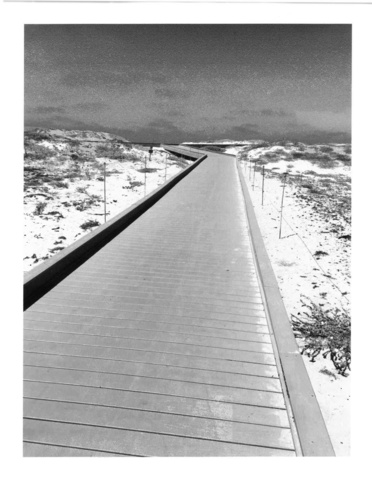
Artist Information:
Dana Teen Lomax - USA
Commemorating:
Abdel Aziz al-Jazem: Lecturer in Islamic Theology at the College of Islamic Science, Baghdad University. [Source: Iraqi Association of University Lecturers report, March 2006].
Artist Statement:
dear-abdel-aziz-al-jazem-
at-the-Pacific-a-path-leads-into-clouds-
imagery-for-your-teaching-of-theology-my-work-in-poetry-
both-acts-of-belief-
we-each-have-studied-the-nature-of-being-
sought-evidence-and-divine-clues-
would-we-recognize-one-another-
i’m-trying-to-find-you-here-
where-sand-and-sea-meet-sky-
follow-leading-lines-to-a-vanishing-point-
between-the-human-and-the-godly-
our-search-for-spirit-
waves-within-and-without-
there-are-those-who-find-danger-
in-what-they-cannot-claim-
condemn-the-intricate-design-of-questioning-
abdel-aziz-al-jazem-
the-sound-and-syllables-of-your-name-
how-they-tried-to-erase-them-
i-speak-them-now-a-sacred-text-a-summoning-
here-the-strandline-shows-the-moon’s-pull-on-all-of-us
no-matter-how-anyone-tries-to-remove-the-proof-
of-the-living-or-the-dead-
Translation:
عبدالعزيز الجاسم: محاضر في علم الكلام بكلية العلوم الإسلامية، جامعة بغداد. (المصدر: تقرير الجمعية العراقية لأساتذة الجامعات، مارس 2006).
العزيز عبدالعزيز الجاسم
من المحيط الهادئ إلى الغيوم
يمتدّ دربٌ مليءٌ بصور تعليمك
وبعملي الشعريّ
كليهما.. صكوك إيمان
درسنا طبيعة الوجود
بحثنا عن دلائله
وأسراره الإلهية
ترى.. هل سيعرف بعضنا بعضاً؟ ؟
أبحث عنك هنا
حيث يلتقي البحر.. والرمال بالسماء
يتتبعان الخيوط الدالة إلى حيث العدم
بين العمل الإنساني والإلهي
يتذبذب بحثنا عن الروح
داخلها وخارجها
هناك من يُهدّدون
على ما لا يمكنهم المطالبة به
هذا ما يدين
نظام التشكيك المعقّد ذاته..
عبالعزيز الجاسم
كيف حاولوا مسح اسمك
حروفك.. وطريقة نطقها
أستدعيها الآن للمثول
كنص مقدّس
يكشف حد الشاطىء
عن مدّ القمر..
يكشفه لنا جميعًا
مهما حاول أحدهم أن يمسح الدليل
دليل الأحياء.. أو الموتى
دانة تين لوماكس (الولايات المتحدة الأمريكية)
#162 Thamer Kamel Mohamed
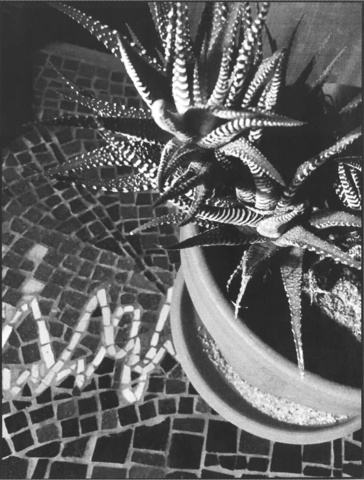
Artist Information:
Felicia Rice
Commemorating:
Thamer Kamel Mohamed, Head of the Department of Human Rights at the Ministry of Higher Education in Baghdad, died February 22, 2010.
Artist Statement:
The succulent Haworthia attenuata in this photograph has the ability to store water for use if water becomes scarce. Its armor of tough skin and spines protect it from physical violence. Thamer Kamel Mohamed was the Head of the Department of Human Rights at the Ministry of Higher Education in Baghdad when he was gunned down by professional assassins with silencers on a busy city street on February 22, 2010.
In the midst of the chaos of the occupation and the sectarian fighting in Iraq it is almost to be expected that Thamer Kamel Mohamed would be targeted. I can only imagine the tough armor Thamer Kamel Mohamed must have worn to venture out each day to go to work in the Human Rights Department, knowing the risks he t ook. His integrity and belief in our common humanity must have driven him. I know as a printer my job is to confront complex issues and render my response to them in book form. As an artist my job is to do so with profound integrity, and as a publisher, my job is to make these issues public. As printers have done every decade since Gutenberg, I'm here to respond to the ongoing tragedy of dehumanization and to argue for a more just society. How quickly the loss of a single life can become a numbered statistic.• The mosaics in this photograph appear as a graphic depiction of these atrocities.
After WWII the international community in the form of the United Nations established the Universal Declaration of Human Rights establishing basic rights and freedoms that belong to every person in the world, from birth until death. Human rights include the right to life and liberty, a right violated when Thamer Kamel Mohamed's life was taken in 2010.
Translation:
#162 لثامر كامل محمد
لنبتة الهاورثيا في هذه الصورة قدرة على تخزين المياه واستخدامها في حال ندر وجودها. تغطيها الأشواك بحيث تحميها من العنف. كان ثامر كامل محمد رئيسًا لقسم حقوق الإنسان في وزارة التعليم العالي في بغداد عندما اغتيل برصاص عصابة محترفين في شارع مكتظ في العاصمة بتاريخ 22 فبراير 2010.
في وقت كانت تعم فيه الفوضى بسبب الاحتلال والاقتتال الطائفي في العراق كان من المتوقع أن يستهدف ثامر كامل محمد. أتخيل الدرع الصلب الذي كان من المرجح أن يلبسه ثامر كامل محمد في كل مرة يترك فيها بيته ويذهب للعمل في قسم حقوق الإنسان، ويتحمل فيها خطورة احتمال استهدافه. من المؤكد أن ما كان يدفعه لذلك هو نزاهته وإيمانه بإنسانيتنا المشتركة. بصفتي مسؤولةٌ عن (حرفة) الطبعْ أعرف أن وظيفتي تعني مواجهة الأمور المعقدة والوصول للنتيجة النهائية وصياغتها في كتاب. وبصفتي فنانة أنا بحاجة لفعل ذلك بكثير من الأمانة، وبصفتي ناشرة أنا مسؤولة عن جعل هذه القضايا قضايا عامة. لعقود طويلة، منذ اختراع جوتنبرغ، كان الناشرون يستجيبون للمآسي البشرية التي تسلخ البشر عن إنسانيتهم، و ويعملون من أجل عالم أكثر عدالة، وهذا ما أفعله أنا أيضاً. كيف يمكن لحياة واحدة أن تتحول ببساطة إلى رقم إحصائي؟ الفسيفساء في هذه الصورة هي دلالة بيانية عن هذه الفظاعة.
بعد الحرب العالمية الثانية أسس المجتمع الدولي، ممثلاً في الأمم المتحدة، الإعلان العالمي لحقوق الإنسان، مؤسسًا بذلك الحقوق والحريات الأساسية لكل شخص في هذا العالم منذ ولادته حتى مماته. حقوق الإنسان تشمل حقه في الحياة والحرية، هذا الحق الذي صودِرَ عندما صودِرت حياة ثامر كامل محمد عام 2010.
فيليشيا رايس - الولايات المتحدة الأمريكية
#173 Ibrahim Shaeer Jabbar al-Jumaili
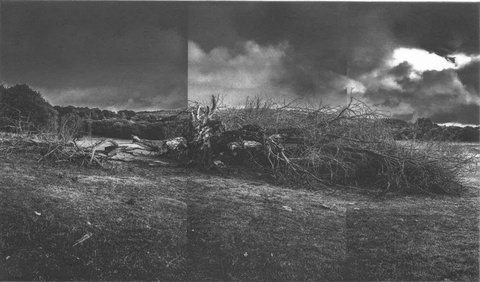
Artist Information:
Tariq Dajani
Commemorating:
Ibrahim Shaeer Jabbar Al-Jumaili: pediatrician and professor of Medicine at Kirkuk University. Dr. Ibrahim S.J. Al-Jumaili, 55 years old, was murdered July 22, 2011, after he resisted attempts by four people to kidnap him, police said.
Artist Statement:
My early morning routine includes walking my dogs in the Spanish countryside where I live. For weeks my thoughts were not of the peaceful nature around me but of making a picture in memory of Al-Jumaili, where his environment was far from peaceful. What were my feelings and thoughts? What picture could I make in his memory? Then it suddenly came to me. It was there all along, but as with many things in life, we sometimes can't see the obvious.
The fallen oak tree lay in the field set apart from other trees, it's trunk shattered, spilt into two. It appeared to have been destroyed naturally. Closer inspection revealed that its fallen branches now provided shelter and refuge for other living creatures: birds, field mice, insects. The spiral of nature brings both death and life.
Trees, contrary to common belief, prefer the entanglement of other trees. Forests thrive better when they are natural, not managed by humans. It crossed my mind that had this tree not been isolated from a forest of oaks, its destruction might have been less severe.
If we humans could 'look through each other's eyes for an instant' as Thoreau wrote, we might see that we are essentially of the same community. If we could see this, instead of isolating ourselves into separate groups, would we inflict such terrible destruction on our own kind? Perhaps. Yet the many horrors of Rwanda and elsewhere tell us that we have much to learn.
Perhaps someday we will learn that we are all part of the whole, connected through the forces of nature. We may not understand this, but instinctively we know it is true: what affects you, affects me, affects us all. Our task, if there ever was one, surely must be to find our way to spiritual oneness.
Translation:
إبراهيم شعير جباره الجميلي
أكاديمي
الدكتورإبراهيم شعير جباره الجميلي: طبيب أطفال وأستاذ طب في جامعة كركوك. وفقاً للشرطة الدكتور إبراهيم الجميلي، ذا ال55 سنة، قُتل في ال22 من يوليو 2011 بعد مقاومته لمحاولة اختطاف من قبل أربعة أشخاص. المصدر: وكالة فرانس برس، 22 يوليو 2011.
بيان الفنان
اعتدت المشي مع كلابي كلّ صباح في أرياف إسبانيا، حيث أسكن. ما كنت مشغولا أسابيع عدة بالتفكير في الطبيعة المسالمة حولي، بل بعمل صورة تخلّد ذكرى الجميلي.، الذي قضى نحبه في بيئة أبعد ما يكون عن السلام . ما الذي شعرت به؟ أي صورة يمكنني التقاطها لتعبّر عن ذكراه؟ وفجأة خطرت في بالي فكرة شعرت بأنها لطالما كانت في بالي، ولكن كالعادة، ومثل أي شيء آخر في الحياة، أحيانًا لا نستطيع رؤية ما هو بديهي.
شجرة البلوط الملقاة في الحقل بعيدًا عن الأشجار الأخرى محطّم جذعها ومنقسم إلى نصفين. يبدو أنه تدمّر بشكل طبيعي. إذا فحصته عن قرب وجدت أن أغصانه الملقاة توفّر مأوىً لكائنات أخرى، مثل الطيور والفئران والحشرات. الطبيعة تُنجب الحياة والموت معًا.
بخلاف الاعتقاد السائد تفضّل الأشجار التشابك مع الأشجار الأخرى. في الحقيقة تزدهر الغابات على نحو أفضل عندما لا تقترب منها أيدي البشر، عندما تنمو بمفردها. تساءلت : لو لم تكن هذه الشجرة معزولة ومنفردة بعيدًا عن غابة أشجار البلوط أكان من الممكن أن تكون أقلّ دماراً؟
لو استطعنا، نحن البشر، " أن ينظر بعضنا في عيون بعض لجظة"، كما قال " ثورو"، لربما وجدنا أننا ننتمي للجماعة ذاتها. لو كان لنا القدرة على ذلك بدلا من عزل أنفسنا في جماعات منفصلة أكنّا سنوقِع هذا الضرر البالغ علينا جميعًا؟ ومع ذلك نتعلم من الفظائع في رواندا وغيرها أن هناك الكثير مما يجب علينا تعلّمه.
قد نتعلّم يومًا ما أننا جزء من الكل،أننا متصلين عن طريق قوى الطبيعة. قد لا نفهم هذا، لكننا نعرف أنه صحيح بالفطرة: ما يؤثر فيك يؤثر فيّ ، ويؤثر فينا جميعاً. إن مهمتنا، إن كان لنا مهمّة، هي أن نجد طريقنا إلى الوحدة الروحية.
--طارق دجاني
#178 Eman Abd-Almonaom Yunis
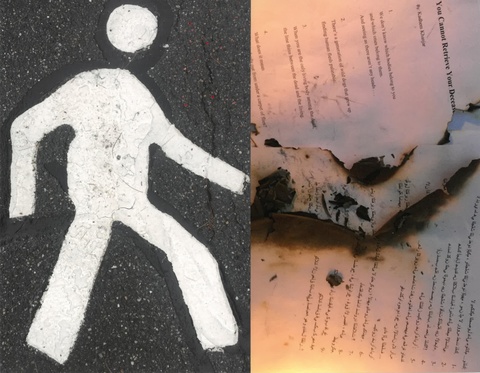
Artist Information:
Translated by David Allen Sullivan
Photo collage on paper.
Commemorating:
Eman Abd ʻAbd Al-monaom Yunis: PhD in translation, lecturer in the College of Humanities, Mosul University, Nineveh. Killed August 30, 2004.
Artist Statement:
How can I honor someone I've never met? How can I comment on someone whose life is only rendered for me between parentheses? (Eman Abd ʻAbd Al-monaom Yunis: PhD in translation, lecturer in the College of Humanities, Mosul University, Nineveh. Killed August 30, 2004.) The hard slap of names and dates. No mention of family members, loved ones, favorite drinks and foods—an insult to the fullness of life. Nothing about her favorite souk, the kind of clothes she wore, what languages she translated from and to, where her colleagues liked to picnic with her, what she felt staring up into the branches of a juglan tree with the sky cut into shards of blue, a lone plane drilling through.
To honor this woman, I've created paired images of absence. The top half is a photo of burned fragments from a poem about trying to retrieve a body from a morgue in Iraq by Kadhem Khanjar, which I co-translated with the author. The bottom is a silhouette printed on streets in the U.S. that reminds us to watch out for pedestrians. Turned on its side it resembles the outlines police make around dead bodies.
Rather than write about Eman Abd-Almonaoin Yunis' assassination, I wrote this poem as a prayer to hold off death—at least for a time imaginatively.
Poem for Eman Yunis
This poem celebrates a wedding in an olive grove by the Tigris, just outside Nineveh.
Plates of falafel wear the blood moons of tomatoes, and the shanks of lambs are flyless, riding on beds of red onions.
This poem holds back the bomb strike, fuses to let wire meet wire and set off the IED.
Rifles that are fired will smuggle bullets into fields where no one walks. On this day lips pressed against lips will be the only fireworks.
Today
kibbeh is broken and only camel meat's found inside.
Today
the young dance with the old while words hold death at bay. A father has his daughter ride his boot toes as he teaches her the steps.
Men dance with men, women with women, and cries rise and explode in a painted blue sky. Nothing stands in their way today, when the poem sings celebration
and,
just this once,
gets away with it.
Translation:
ترجمة :شعر لديفيد آلين سوليفان إحياءً لذكرى
إيمان عبدالمنعم يونس
كولاج على الورق
كيف يمكن لي تخليد ذكرى أحد لم ألتق به؟ كيف يمكن لي التعليق على حياة أحد بشكل مختصر وبين قوسين فقط؟ (إيمان عبد المنعم يونس: دكتوراه في الترجمة، محاضرة في كلية الآداب والعلوم الإنسانية في جامعة الموصل في نينوى. قتلتْ في ال30 من أغسطس عام 2004.) تصفعني الأسماء والتواريخ. لا ذكر لأفراد عائلتها وأحبّتها والأطعمة والمأكولات المفضلة بالنسبة لها.. غياب التفاصيل هو إهانة لامتلاء حياتها. لا شيء عن سوقها المفضل ونوع الملابس التي كانت ترتديها واللغات التي كان تترجم منها وإليها. إلى أين كانت تحب أن تذهب في رحلة مع زملائها ؟ ما الذي كانت تشعر به وهي تحدّق في أغصان شجرة الجوز، السماء الزرقاء التي تقطع صفاءها طيارة وحيدة؟
تخليدًا لذكرى هذه المرأة صممت صورًا مزدوجة عن الغياب. الجزء الأعلى هو كولاج لأبيات قصيدة محترقة الأطراف مقتبسة من قصيدة للشاعر كاظم خنجر الذي ترجمتُ أبيات قصيدته بالتعاون معه. الجزء السفلي لوحة ظلّيّة مطبوعة على الشوارع في الولايات المتحدة الأمريكية تذكرنا بالانتباه للمشاة. عندما تقلب الصورة على الجانب، تشبه الصورة الخطوط التي ترسمها الشرطة حول الجثامين.
عوضًا عن الكتابة عن مقتل إيمان عبد المنعم يونس كتبت هذه القصيدة راجيًا تأجيل وفاتها، حتى وإن كان ذلك التأجيل متخيّلًا فقط.
قصيدة ل إيمان يونس:
تحتفي هذه القصيدة بحفل زواج في بستان زيتون
بالقرب من نهر دجلة، خارج نينوى
تزيّن أطباق الفلافل
الطماطم الحمراء
على قطع اللحم
ترتاح رقائق البصل
تمسك القصيدة بالقنبلة
كي لا تنفجر
تمنع الأسلاك من الالتقاء
لئلّا تشتعل العبوة الناسفة
ستهرب بعض الذخيرة
من البنادق
للميادين التي لا يمشي عليها أحد
لن تطلق النار احتفالًا
سيكون الاحتفال الوحيد
هو التقاء الشفاه بالشفاه
اليوم
قطع الكبة مكسورة
لا تجد فيها الّا لحم جمل
اليوم يرقص الكبار مع الصغار
بينما تحمل الكلمات الموت على الخليج
يعلّم الأب ابنته الصغيرة المشي..
وهي تضع قدميها على طرف حذائه
يرقص الرجال مع الرجال
ترقص النساء مع النساء
ترتفع الصيحات وتنفجر في السماء الزرقاء
لا شيء يوقفهم اليوم
عندها تصدح القصائد احتفالًا
للمرة الأخيرة ...
#180 Leila (or Lyla) Abdu Allah al Saad
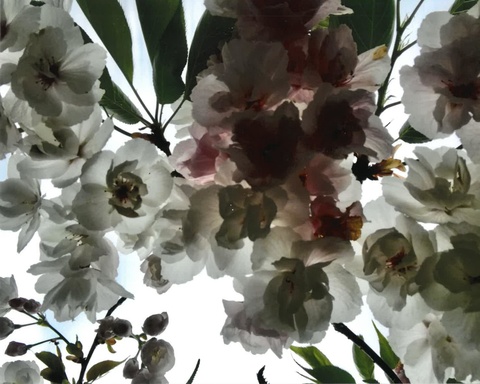
Artist Information:
Persis Karim
“In the Time of Cherries”
Commemorating:
180. Leila [or Lyla] Abdu Allah al-Saad: PhD in law, dean of Mosul
University‘s College of Law. Assassinated in June 22, 2004.
Artist Statement:
I have been thinking about how few women were on this list, and I wanted to connect with an Iraqi woman academic and professor. I saw Leila’s name, and I wondered what it took to become a Dean of the College of Law. She must have worked hard, sacrificed things—she must have believed in the law, even when others were cynical and angry at the system, or already frustrated with the law and politics even before the US occupation. I thought of how women teachers inspire others—particularly women students. I even did a search for Leila’s name, hoping to find something out about her—where she was born, what her passions were, what, if anything, she wrote about. The caption, here, at the top of the poem is all I found.
As we’ve endured the COVID-19 “shelter-in-place” here in California this past 30 days, I thought about how such an idea wasn’t likely possible for Leila or her colleagues or students. They worked even if they didn’t get paid; they worked for their students and to believe that despite the occupation and the violence, they had to show up for their students. They wanted to believe that things would get better and that something worthwhile and transformative might follow such a major historical event as an occupation by the US. I imagined her knowing her life might be in danger, but showing up for her students and her colleagues might have given her hope and a sense of purpose. And, I have been also thinking about flowers and the way each tree, plant, or bush, comes into its flowering at a particular time of the year. This is a photograph of the ornamental cherry tree in my backyard. I thought of Leila today. How she was not able to fulfill her destiny and how the season of her life was cut short but how her life, I am certain, had an impact on her students. I want to say her name, so that she will not be forgotten. So that she will continue to bloom.
Translation:
بيان الفنان - "في زمن الكرز"
برسيس كريم
180. لَيْلَى عبد الله السعد: دكتوراه في القانون وعميدة كلية القانون بجامعة الموصل .اغتيلتْ في 22 يونيو 2004.
كنت أفكر في العدد القليل من النساء اللواتي على هذه القائمة ، وأردت التواصل مع أكاديمية وأستاذة عراقية. رأيت اسم ليلى وتساءلتُ عما تطلبهُ الأمر حتى أصبحتْ عميدة لكلية القانون. لابد أنها عملت بِجدٍّ وضحّت بأشياء. يجب أن تكون قدْ آمنت بالقانون، حتى عندما كان الآخرون ساخرين وغاضبين من النظام أو محبطين من القانون والسياسة حتى في مرحلة ما قبل الاحتلال الأمريكي. فكرت في كيفية إلهام المعلمات للآخرين - وخاصة الطالبات. حتى أنني قمت بالبحث عن اسم ليلى على أمل أن أجد شيئًا ما عنها كمكان ولادتها أو شغفها أو كتابتها، إن وجدت. التسمية التوضيحية في الجزء العلوي من القصيدة هي كل ما وجدته.
في الوقت الذي اجتزنا فيه صعوبات قرار لزوم البيت بسبب وباء فيروس كورونا هنا في كاليفورنيا خلال الثلاثين يومًا الماضية فكرتُ في استحالة فكرة كهذهِ على الأرجح أمام ليلى أو زملائها أو طلابها. لقد عملوا حتى لو لم يتقاضوا رواتبهم. عملوا من أجل طلابهم وآمنوا أن عليهم عليهم الحضور من أجل هؤلاء الطلاب بالرغم من الاحتلال والعنف (الذي يواجهونه). أرادوا التصديق بأن الأمور ستتحسن وأن شيئًا ذا قيمة وتغيير جذري قد يلي حدثًا تاريخيًا كبيرًا مثل احتلال الولايات المتحدة. تخيلتُ أنها تعلمُ أن حياتها قد تكون في خطر، لكن الحضور من أجل طلابها وزملائها ربما منحها الأمل وإحساسًا بالهدف. وكنتُ أفكر أيضًا في الزهور وطريقة ازدهار كل شجرة أو نبات أو شجيرة في وقت محدد من السنة. هذه صورة لشجرة الكرز المزخرفة في الفناء الخلفي لمنزلي. فكرت في ليلى اليوم وكيف أنها لم تكن قادرة على تحقيق مصيرها وكيف اختُصِرَتْ حياتها رغم اني متأكدة من الأثر الذي خلفته حياتها على طلابها. أريد أن أقول اسمها حتى لا تنسى و تستمر في الازدهار.
#183 Muneer al-Khiero
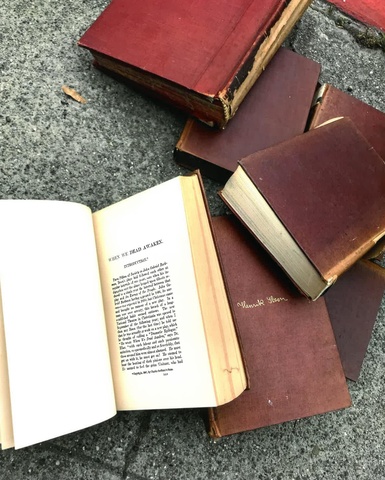
Artist Information:
Persis Karim
“When We Dead Awaken”
Commemorating:
183. Muneer al-Khiero: PhD in law and lecturer in the College of Law, Mosul University. Married to Dr Leila Abdu Allah al-Saad, also assassinated. Date unknown.
Artist Statement:
I wrote the first poem for Leila “In the Time of Cherries,” and after I finished it and sent a draft to Beau, he asked me to consider writing a second poem for her husband (also listed) in the Mosul section. I immediately said yes. I was struck by even how much less information there was about him. Not even an exact date of his assassination. I was troubled by this. The next morning, during the third week of the COVID-19 “Shelter in Place,” I took a walk up to my bank, I was on a mission to buy some things at a corner market on my path up Ashby Avenue in Berkeley. Just before I reached a corner store a few blocks west of my bank, I encountered a stack of books which had clearly been put on the curb for any takers. They were old, slightly beat-up editions of a collection of Henrik Ibsen plays. They had been taken out of the box, and clearly someone had handled them before I found them. One of the books was open to the page that introduced the play, “When We Dead Awaken.” It hit me then, that this would become my picture and it would also be the inspiration for the poem I would write. The play features a character named Professor Rubek and his wife Maia. I knew immediately that this book opened to that page was meant to be mine, and even though I thought I should not be picking up someone’s stray books in the time of a pandemic, I took it home with me anyway. I like Ibsen and I also learned Norwegian when I was an exchange student, but I was unfamiliar with this play.
This photograph and poem are dedicated to Muneer Al-Khiero, the husband of Dr. Leila Abdu Allah al-Saad, Dean of the College of Law who was also murdered.
Persis Karim – USA
Translation:
# 183. منير الخيرو: دكتوراه في القانون ومحاضر في كلية القانون جامعة الموصل. متزوج من الدكتورة ليلى عبد الله السعد ، اغتيلتْ هي أيضاً. التاريخ غير معروف.
بيان الفنان: "عندما نُبعث نحن الموتى " برسيس كريم
كتبت القصيدة الأولى لليلى "في زمن الكرز"، وبعد أن انتهيت منها، وأرسلت مسودة إلى بو، طلب مني التفكير في كتابة قصيدة ثانية لزوجها المذكور أيضًا في قسم جامعة الموصل. وافقتُ على الفور. لقد صُدمتُ لقلة المعلومات المتوفرة عنه، حتى أنّ موعد اغتياله غير معروف . لقد أزعجني هذا. في صباح اليوم التالي مشيت إلى البنك خلال الأسبوع الثالث لقراراللزوم في المنزل في وقت جائحة كوفيد 19، وكنت أرغب بشراء بعض الأشياء من السوق في زاوية شارع أشبي في بيركلي. قبل أن أصل إلى المتجر في زاوية الطريق على بعد عدة مبانٍ غرب مبنى البنك وجدتُ كومة من الكتب وُضعت على الرصيف لمن يرغب .كانت طبعات قديمة ومهترئة بعض الشيء لمجموعة من مسرحيات هنريك إبسن. كانت الكتب قد أخرجت من الصندوق ، ومن الواضح أن شخصًا ما كان قد فتّشها قبل أن أجدها. كان أحد الكتب مفتوحًا على صفحة مقدمة مسرحية "حينما نُبعث نحن الموتى". خطر لي حينها أن هذه الصفحة ستكون الصورة التي سألتقطها و مصدر إلهام للقصيدة التي سأكتبها أيضًا.
تضمُ المسرحية شخصية تدعى الأستاذ روبيك وزوجته مايا. علمت على الفور أن هذا الكتاب الذي فُتح على تلك الصفحة كان من المفترض أن يكون لي. وعلى الرغم من أنني عرفتُ أنه لا ينبغي عليّ التقاط كتب مرميّة لشخص ما في وقت انتشار الوباء أخذته معي إلى المنزل على أي حال. أحبُ إبسن ، وقد تعلمتُ اللغة النرويجية عندما كنت طالب تبادل ثقافي، لكنني لم أكن على دراية بهذه المسرحية.
هذه الصورة وهذه القصيدة مهداتان لمنير الخيرو، زوج الدكتورة ليلى عبد الله السعد عميدة كلية الحقوق التي اُغتيلت هي أيضاً.
برسيس كريم - الولايات المتحدة الأمريكية
#197 Identity unknown
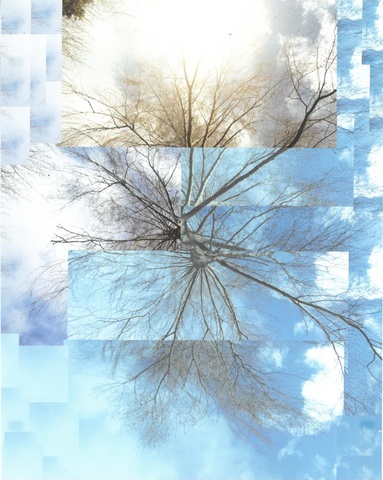
Artist Information:
Carl Middleton - UK
Commemorating:
Unknown: Lecturer at Mosul University killed in the explosion of two car bombs near campus, October 1, 2007. In this attack six other people were injured, among them four students. (Source KUNA, October 1, 2007).
Artist Statement:
The photograph combines a number of images of the same subject – a ‘joiner’ of a single Silver Birch tree. A fragile, tall, middle-aged tree (in human terms) with a canopy of frail but very beautiful foliage.
This is the third creative response I have made as part of the ‘Al-Mutanabbi Street Starts Here’ collaborations. In each piece of work I have tried to move beyond the incidents themselves. From my perspective the subject matter is just too dark to figuratively represent in any way. For this reason I elected to photograph something more navigable, something that would afford a different kind of contemplative response: a tree.
Trees are one of the most singular natural elements common to all cultures. Welcoming birds to nest within and rest, animals for shade, climbed and enjoyed by children, providing contemplative spaces and nourishment for humans and when harvested made into furniture to sit on, bowls to eat from and pencils to write with, cut into logs and burnt for warmth, and of course pulped and made into paper.
The photograph depicts a single element in a much wider life cycle, but also ironically is the picture of the ‘thing’ that it is made from – tree to paper and back to tree. The photograph’s distant relative, a physical link from itself, out and back to itself.
Translation:
العنوان: شجرة العائلة
#١٩٧ الشخص مجهول: محاضر في جامعة الموصل، قتل في انفجار سيارتين مفخختين قرب الحرم الجامعي في 1 أكتوبر 2007. وأصيب ستة أشخاص بجروح بينهم أربعة طلاب. (المصدر كونا، 1 أكتوبر 2007).
بيان الفنان
هذه الصورة الفوتوغرافية عبارة عن مجموع أجزاء من صورة شجرة البتولا الفضية. شجرة طويلة وهشة في منتصف عمرها (لو كنّا سنستخدم التعابير البشرية). تظلّلها أوراق الشجر الهشّة والجميلة.
هذه هي ثالث محاولة إبداعية قمت بها كجزء من المشروع التعاوني "شارع المتنبي يبدأ هنا". في كل محاولة، كنت أسعى لتجاوز المواقف نفسها. بالنسبة لي، المواضيع المتناولة كئيبة أكثر من أن تُقدّم بشكل مجازي. ولذلك، فقد اخترت تصوير شيء يمكن تجاوز اللغة عبره، شيء يمكننا تأمله والتفكير فيه، كشجرة مثلًا.
تُعدّ الأشجار من أكثر العناصر الطبيعية التي تشترك فيها جميع الثقافات. توفّر الأشجار وظائف عدّة، مثل الترحيب بالطيور لبناء أعشاشها، توفير الظل للحيوانات، توفير متعة التسلق للأطفال، ومساحات التأمل للبشر. وعند حصادها توفر أثاثًا للجلوس وأقلام رصاص للكتابة، وحطبًا لإشعال النار والتدفئة، وورقًا للاستخدام.
هذه الصورة الفوتوغرافية تُصوّر عنصر طبيعي كجزء من دورة حياة أوسع.
المفارقة هنا هو أن صورة «الشيء» مصنوعٌ منه - من شجرة إلى ورقة ثم إلى الشجرة مرة أخرى. فتكون الشجرة قريبة الصورة بعيدا عنها لكن مرتبطة بها عبر رابط مادي يخرج منها ويعود اليها.
الاسم: كارل ميدلتون
الدولة: المملكة المتحدة
#240 Karem Mohsen
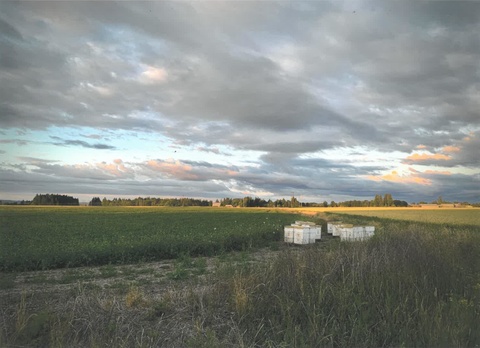
Artist Information:
Laura Russel
Commemorating:
Karem Mohsen, Lecturer, Basra University, College of Agronomy
Artist Statement:
And your Lord inspired the Bee.
So says the Ouran,
a hadith by the Prophet Mohammed.
There comes forth from their bellies
a drink of varying colour
wherein is a healing for men.
Verily, in this is indeed
a sign for people who think.
Bees are venerated in this hadith.
Diligence, sacrifice, knowledge,
an example for humankind,
the importance of collective.
Insects, animals, plants, people,
at once, related, dependent, endangered,
creatures of the Ouran, creatures of God.
Karem Mohsen, PhD, Basra, Iraq,
professor of the honeybee.
Always, always in the service of bees
tending his hives in solitude, in prayer.
For this, targeted, assassinated
10 April 2006.
Fellow lecturers and students rise up,
demonstrate, protest, honor. Anguish.
Again and again, academics, erased,
intimidated for lighting
the interconnected nature of life itself,
of knowledge and truth,
of shadow and light.
A sign for people who think.
Translation:
كريم محسن (# ٢٤٠)
ملخص أكاديمي
كريم محسن: دكتوراة في الزراعة ومحاضر في قسم الزراعة في كلية الزراعة في جامعة البصرة. قُتل في ١٠ أبريل ٢٠٠٦. عمل في مجال إنتاج نحل العسل. ودعا المحاضرون والطلاب إلى مظاهرة احتجاج على اغتياله.
تصريح الفنان
"وأوحى ربك إلى النحل"
هكذا يقول القرآن،
"يخرج من بطونها
شراب مختلف ألوانه
فيه شفاء للناس
إن في ذلك لآية لقوم يتفكرون"
النحل يُكرّم في هذه الآية.
الاجتهاد والتضحية والمعرفة
مثال للبشرية ،
أهمية الجماعية.
الحشرات والحيوانات والنباتات والناس،
في وقت واحد، مرتبطة، تابعة، معرضة للخطر،
مخلوقات القرآن،
مخلوقات الله.
كريم محسن، دكتوراه، البصرة، العراق،
أستاذ نحل العسل.
دائما ، دائما في خدمة النحل
يرعى خلاياه في العزلة، في الصلاة.
لهذا، استهدف، اغتيل في
١٠ أبريل ٢٠٠٦.
الزملاء المحاضرين والطلاب انهضوا،
تظاهروا واحتجوا وتشرّفوا. هي معاناة.
مرارًا وتكرارًا مُحي الأكاديميون،
ترهيبًا لإضاءة طبيعة الحياة المترابطة
طبيعة المعرفة والحقيقة
طبيعة الظل والنور.
"إن في ذلك لآية لقوم يتفكرون".
لورا راسل
#245 Kathum Mashhout
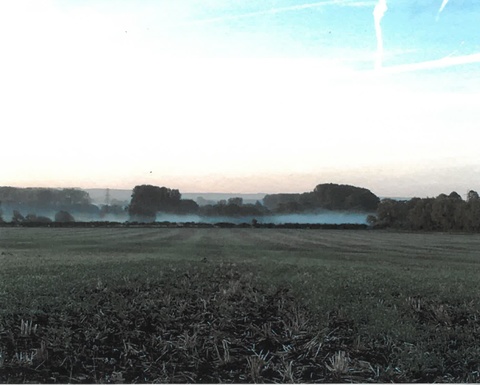
Artist Information:
Mavina Baker - UK
inkjet print on Hahnemühle paper
Commemorating:
Kathum Mashhout: Lecturer in edaphology at the College of Agriculture, Basra University. Killed in Basra in December 2006 [exact date unknown]. [Source: CEOSI Iraqi university sources, 72 December 20061
Artist Statement:
Edaphology: relating to the soil. Any property of the soil, physical or chemical, that influences the plants growing in that soil. How can someone lecturing on the effect of soils on the growth of plants be seen as an enemy, it beggars belief. These killings are a shameful and random, violent attempt to shut down academic freedom, free speech and the sharing of knowledge.
Standing in silence and looking out at the sun rising on a green washed autumn morning, as mist settles and shifts, I'm looking for an echo, an idea of a man I will never meet . . did he ever stand, wonder, alone to watch the sun rise over dew soaked fields, watching mist in the valley and vapour trails in the sky; Shifting, fluid transient and temporary as dreams.
Unlike the soil underneath my feet. The rich loam on which I stand, home to a myriad life forms, land that has been husbanded for generations (was he a husband? . . a father? . . did he love, & was he loved in return?) Would he have recognised anything of his Fertile Crescent, the birthplace of agriculture, in these scratchy, stubble grazed fields of a soft, still, northern hemisphere morning?
study the view again and watch the light change to a brighter hue as the day gathers strength. Iffs beautiful to watch. It is calm and so very still. Not quite alone, I am here carrying with me the ghost of a man I've never seen, into a wide open, and deserted field to find some trace resonant with another, so we can watch the light change together.
Hearing them first, I become aware of a horde of crows tearing out from the trees, racing to harry a red kite. Falling into air. Plunging at her head with bitter black cries, their dark shapes wheeling over the land. I watch discomfited at their shadows running. Disconnected. Spinning. Coursed on like a hare.
Dropping my phone. Stooping to touch the soil; and I see for one flickering instant as if through the cataracts of a ghost’s clouded eye.
Translation:
العتبة
مافينا بيكر
المملكة المتحدة
inkjet print on Hahnemühle paper
#245 كاظم المشحوط: محاضر في علم التربة في كلية الزراعة، جامعة البصرة. قتل في البصرة في ديسمبر 2006 (التاريخ الدقيق غير معروف). (المصدر: CEOSI مصادر من جامعات عراقية، 12 ديسمبر 2006)
علم التربة وكل ما يتعلّق بها، دراسة خواصّ التربة، سواء كانت فيزيائية أو كيميائية التي تؤثر في النباتات التي تنمو فيها. كيف يمكن لشخص يحاضر في تأثير التربة على نمو النباتات أن يُرى عدوّأً؟ هذا شيء يصعب تصديقه. عمليات القتل هذه مخزية وعشوائية. هي محاولات عنيفة لإيقاف الحرية الأكاديمية وحرية التعبير ومشاركة المعرفة.
أقف بصمت، أتأمل شروق الشمس في صباح خريفيّ. وبينما يحلّ الضباب وينقشع، أبحث عن صدىً.. أبحث عن صورة لرجل لن ألتقي به أبدًا. وأتساءل: هل وقف يومًا ما وحده يطالع شروق الشمس على الحقول النديّة، يراقب الضباب يملأ الوادي، وقطع السحاب في السماء تتحول وتسيل عابرة ومؤقتة كالأحلام.
لا كما التربة التي تحت قدميّ، الطين الذي أقف عليه موطن لما لا يُحصى من حيوات الكائنات، وأرض رعيت لأجيال. هل كان أبًا، زوجًا؟ هل أحبّ وأحبّه أحد؟ هل كان سيستوعب أن هذا الحقل الشائك، الذي ترعى فيه الحيوانات وتترك أعشابه مقطّعة، في يوم هادئ ورقيق في النصف الشمالي من الكرة الرضيّة، يشبه أي شيء من الهلال الخصيب حيث ولدت الزراعة؟
يزداد الضوء بريقًا كلّما تقدّم الوقت خلال اليوم ما أجمل هذا المشهد! هادئ وثابت. لست وحدي. أحمل معي روح إنسان لم أره قطّ. أحمله لهذا الفضاء الصحراويّ الواسع أبحث عن ألفة مع أحد لنتأمل تغيّر الضوء معًا.
سمعت أصواتًا. التفت فإذا بحشدٍ من الغربان تخرج من الأشجار هاربة من طائرة ورقية حمراء
سقطت عليها. تتخبط الغربان في الهواء، وتصرخ صرخات سوداء مريرة ، وظلالها السوداء تهرب، تتقطّع،
تتدحرج على الأرض كأرانب بريّة فارّة.
رميت هاتفي وانحنيت لألمس التربة، وللحظة، شعرت بأني أرى من خلال عيون شبحٍ معتمة.
#246 Mohammed Aziz Alwan
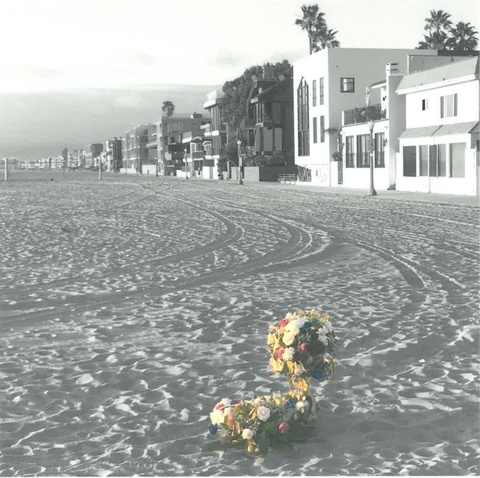
Artist Information:
Jim Natal -Los Angeles, USA
Beach Shrine
Color inkjet printing on matte photo paper
8.5 x 11 inches
Commemorating:
MOHAMMED AZIZ ALWAN: Lecturer in artistic design at the College of Fine Arts,
Basra University. Killed by armed men 26 May 2007 while walking in the city.
Artist Statement:
I went for a walk, down to the beach at Marina del Rey.
There was a woman sitting lotus in the sand, a shrine
of flowers spread around her as she gently rocked back and forth
facing the shore. Out of respect for her ceremony I passed by,
continued to the far end of the jetty where sea lions bask
close enough to hear them bark and the boats turn right beyond
the foghorn into the reality of the ocean. The only time
I’ve ever made that turn was for a burial at sea, ashes and petals
strewn upon the wake, three times in a circle. Pods of dolphins
escorted us all the way back to the breakwater. The woman
on the beach was gone when I returned. But her shrine was
still there, just as she had left it—for a spouse, a parent,
a love or lost friend? Or maybe it was in memory of
Mohammed Aziz Alwan or the too many someone else's like him.
I stopped this time and took a photo. A young boy approached,
stood beside me. “I was going to take that same picture,” he said. I went for a walk.
Alwan went for a walk. One of us got to go home.
Translation:
محمد عبدالله الراوي. دكتوراه في الجراحة، ورئيس سابق لجامعة بغداد، وعضو في المجلس العربي للطب والمجلس العراقي للطب، ورئيس الاتحاد العراقي للأطباء. قتل في 7 يوليو، 2003.
لا يخلو منه بيت
جيسيكا بيلت صايم الدهر
الولايات المتحدة الأمريكية، مقيمة في تركيا
"دخل الشاي في مفاصل حياتها، فهو كالخبز لا يخلو منه بيت" (مقولة عراقية).
أنا أيضًا أحب شرب الشاي. وهذا أمر جيّد لشخص يعيش في تركيا محاطاً بالكثير من الأصدقاء والزملاء العراقيين. العراقيون يحبون شرب الشاي الأسود مع الكثير من السكّر، وغالبًا بنكهة الهيل، ويقدمونه في "الاستكانة". هذه الأخيرة تشبه الأكواب المستخدمة هنا في تركيا التي تقدّم غالبًا على صحون الفناجين المزيّنة.
جلست أشرب الشاي، وأقرأ قائمة الثلاثمئة وأربعة وعشرين أكاديميًا عراقيا اغتيلوا، فغمرني الارتباك بسرعة. كيف يمكنني أن أختار اسمًا من بين كل هؤلاء؟ كيف يمكن للكثير منهم أن يبقوا مجهولي الهوية؟ وما أشْعرني بالقلق أكثر من هذا كله هو قائمة الفاقدين الأطول من هذه، أولئك الذين يتجرعون مرّ غياب أحبتهم في كل يوم. لا يوجد شيء اسمه "مجهول الهوية أو غير معروف" لهؤلاء، لأن الفقد باقٍ كهمسات على شفاههم كلما همّوا بشرب الشاي.
وأنا أقرأ الأسماء لفتني اسم الدكتور محمد عبدالله الراوي.
قبل أسابيع مضت شاركني الصديق والزميل الدكتور عازار مالوكي مشاعره حول غزو العراق. خلال محادثتنا شاركني اللحظة التي شعر فيها بأن أيامًا حالكة تنتظر العراق، وذلك حين سمع بمقتل طبيب، ومعلّم له، ورئيس الاتحاد العراقي للأطباء، الدكتور محمد عبدالله الراوي. شرح لي بأن مقتل الدكتور الراوي شكّل له ولأصدقائه نقطة تحوّل في الحرب، مع بداية استهداف العراقيين المفكرين و الاحترافيين.
من خلال ما عرفته عنه عن طريق زميلي، والبحث الذي قمت به على الإنترنت ، وجدت أن د. الراوي كان طبيبًا مبدعًا ومتفوقًا في عمله، وأستاذًا ومديرًا وقائدًا في مجال الطب. كان متزوجًا وله ثلاثة أبناء. كرّس حياته لمهنة الطب، وشجّع زملاءه الأطباء وأنشأ جيلًا مقبلًا من الأطباء. والمناصب المحترمة كلها التي شغلها دليلٌ على براعته في مجاله، من غير وساطات سياسية.
من المؤسف أن اسمه كان على قائمة أخرى تضم أسماء أكاديميين مستهدفين للقتل بعد الغزو الأمريكي للعراق. تقول زوجته، بشرى، إن ردّه على هذه القائمة كان قوله: "لا أعداء لي، أنا عالم وطبيب فحسب".
مما عرفت من خلال بحثي أيضًا أن د. الراوي قُتلَ في عيادته في 27 يوليو عام 2003. دخل رجلان عيادته، شكا أحدهم من ألم حادّ في المعدة، وكان قد أخفى مسدسه، ثم أشهره وأطلق النار عليه أمام زوجته بشرى، والمرضى هناك. آنذاك كان عمر ولده الأكبر 22 سنة وعمر الأوسط 17 وعمر الأصغر 15 سنة.
أعرف أن ذاكرته تحيا الآن من خلال زوجته بشرى، وأولاده، والكثيرين ممن أثرت فيهم حياته بما فيهم طلبته، مثل صديقي د. عزار. ومن خلال هذا المشروع أيضًا. أنا أيضًا أهمس اسمهُ اليوم وأنا أشرب الشاي، حتى إن لم يكن لذلك أثر ملموس.
لا يخلو بيت في العراق من فقيد مات، وما زال حيّاً في الذاكرة.
#248 Muayad Ahmad Jalaf
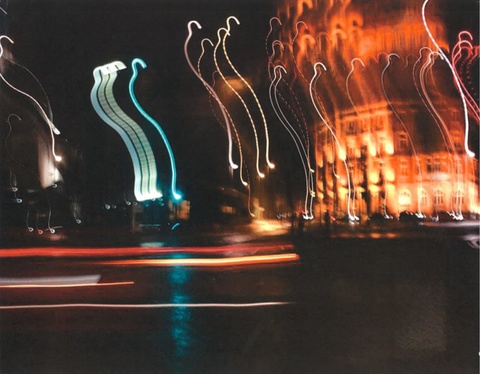
Artist Information:
Amina Atiq - UK/Yemen
Commemorating:
Muayad Ahmad Jalaf, lecturer at the Arts College, Basra University, died September 12, 2017.
Artist Statement:
I never heard of Muayad Ahmad Jalaf until I set out to do this brief. I struggled to write at first because I asked myself how could I as a writer honour his death in the most respectful and dignified way. All I could think about is death, the group of armed young men, the government license plate and his body lying dead in a city suburb. We are forced to think of the worse scenario but what happened in the car? Why did one of the cars have a government plate? Was he an activist? We may never know all the answers but what I know for certain is we have a reasonability to never forget.
The Suburb of Basra
White sheets
Hope is born again in the faces of
the streets- we are forced to forget but
we think we hear a whisper echoing in
the distance- it is death in a figure of
A group of armed young men
Three cars
A government plate
If only war was enough to endure-
fragmented souls and shattered
dreams. But he didn’t return home-
his body lay in the Basra suburb.
Hope died again the faces of the
streets- funeral bells, chanting men
and mourning families- if only the truth
unveiled itself so justice can conquer-
but the blood is swept from the streets
so they may dance again.
But the music has grown numb and his
name lingers in our history books.
Time will heal and the truth will
uncover itself in your white sheets.
In honour we remember- in justice
we tie his name on the tip of our lips-
and very suburb will call his
name and we will follow.
Translation:
أكاديمي: 248. مؤيد أحمد جلاف: محاضر في كلية الفنون بجامعة البصرة. اختطف بتاريخ 10 سبتمبر 2007 من قبل مجموعة مسلّحة كانت تقود ثلاث سيارات، إحدى تلك السيارات كانت تحمل لوحة ترخيص حكومية. وجد قتيلًا في ضاحية المدينة في اليوم التالي. (المصدر: محكمة بروكسل نقلًا عن مصادر من جامعة عراقية، 12 سبتمبر 2007)
لم أسمع بمؤيد أحمد جلاف قبل محاولتي لكتابة هذه النبذة عنه. في البداية، عانيت كثيرًا في محاولتي للكتابة، لأني كنت أتسائل: كيف يمكنني ككاتبة تكريمه بعد وفاته بأكثر الطرق احتراماً وتقديراً؟ لا أستطيع التوقف عن التفكير بالموت، بمجموعة الشباب المسلحين، بلوحة الرخصة الحكومية، وجسده المرمي في ضاحية إحدى المدن. نحن مجبورون على التفكير بأسوأ مشهد ممكن ولكن ماذا عسى أن يكون قد حصل للسيارة؟ لماذا حملت إحدى السيارات لوحة رخصة حكومية؟ هل كان ناشطًا؟ قد لا نستطيع التعرّف على الإجابات مطلقًا.. ولكن ما أعرفه جيدًا هو أن علينا مسؤولية عدم النسيان.
أمينة عتيق
الدولة: المملكة المتحدة \ اليمن
#250 Youssef Salman
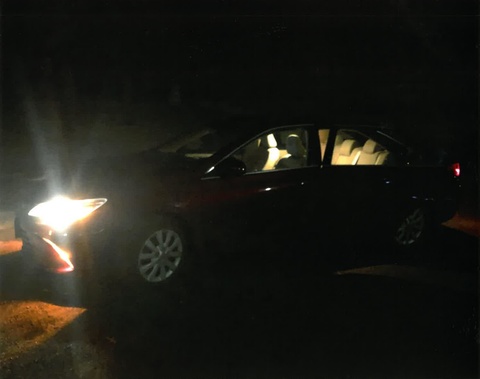
Artist Information:
Emily Martin - USA
Commemorating:
Youssef Salman: PhD engineering professor at Basra University. He was shot dead in 2006 when driving home from the University with three other colleagues, who were spared, according to the information provided by her widow to France24, in a phone interview [Source: France24, July 4, 2008].
Artist Statement:
I struggle to find a way to honor Youssef Salman. I know so little about him beyond that he was murdered. I have so many questions and no way to find many answers. His wife Ibtissem Yakoub was quoted to say that her husband had no political links, so I know he was married, and I also learned that he was an engineer. That gives me a bit of common ground. My Minnesotan father, my Iranian brother-in-law, and my Texas nephew are all engineers of one kind or another. That is a personality type I am very familiar with and one that seems to cross all manner of country and cultural boundaries. This one bit of information lets me feel I know a little about this man, his precision of thinking, his organizing brain, his orderliness of action. Now I can think of him beyond the way that he died.
Youssef Salman was in a car with three colleagues from Basra university. He alone was killed by an unknown gunman while the others were spared. A death so stark, so lonely, so sad.
The photograph I have made is of a stopped car at night, a car door is open illuminating the unoccupied interior.
Translation:
رقم 250. يوسف سلمان: أستاذ حاصل على الدكتوراه في الهندسة كان يعمل في جامعة البصرة. قُتل بالرصاص في عام 2006 عندما كان يقود سيارته إلى منزله من الجامعة، ومعه ثلاثة من زملائه الآخرين الذين أُنقذوا وفقاً لمعلومات قدمتها أرملته إلى قناة France24 في مقابلة هاتفية [المصدر: France24 ، الرابع من يوليو / تموز 2008].
أجد صعوبة في إيجاد طريقة لتكريم يوسف سلمان. أنا لا أعرف إلا القليل عنه، وأنّه قد قُتل. لدي الكثير من الأسئلة، لكنني لا أملك أي طريقة للعثور على إجاباتها. نُقل عن زوجته ابتسام يعقوب قولها إن زوجها ليس له صلات سياسية. وهكذا أعرف أنه كان متزوجاً. وعلمت أيضًا أنه كان يعمل مهندساً. وهنا وجدت بعض الأرضية المشتركة؛ فوالدي، الذي من ولاية مينيسوتا، وصهري الإيراني وابن أخي في تكساس جميعهم مهندسون من مختلف الاختصاصات. هذا نوع شخصية أعرفه جيدًا، ويبدو أنه يتخطى كل البلدان والحدود الثقافية. هذه المعلومة الصغيرة تجعلني أشعر أنني أعرف قليلاً عن هذا الرجل، دقة تفكيره وعقله وعمله المنظم. الآن أستطيع أن أفكر فيه أبعد من التفكير بالطريقة التي مات بها.
كان يوسف سلمان في سيارة مع ثلاثة من زملائه من جامعة البصرة. قُتل وحده على يد مسلح مجهول بينما نجا الآخرون. موت قاس جدا، وحزين جداً، وفي وِحدة تامة
الصورة التي التقطتها هي لسيارة متوقفة في الليل بابها مفتوح ينير داخلها الفارغ.
إميلي مارتن الولايات المتحدة الأمريكية
#269 Mais Ganem Mahmoud
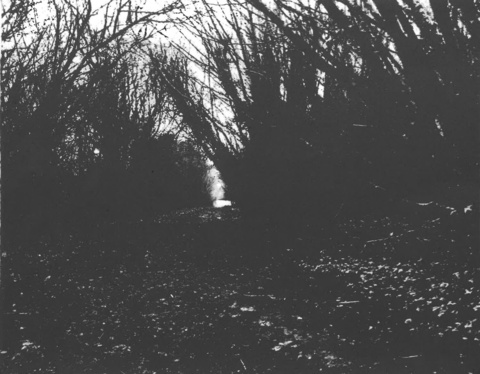
Artist Information:
Catherine Cartwright
Commemorating:
Mais Ganem Mahmoud: Lecturer at Baquba University. Department and college unknown. Killed at the end of April, according to the Iraqi Ministry of Higher Education. [Source: CEOSI university Iraqi sources, 10 May 2006].
Artist Statement:
I chose to reflect on and remember Mais Ganem Mahmoud because the name Mais is familiar to me as an Iraqi women's name. I feel very sad that there is so little information about her, just that she was a lecturer at Baquba University and killed at the end of April 2006.
The photo was taken in woodlands on the River Dart in Totnes, South Devon (South West England, UK). They are on the site of a 19th century rifle shooting range, which today is a nature reserve. That it is now a refuge for wildlife rather than a place of threat - symbolises for me, the hopeful metamorphosis of insecurity and violence to safety and peace for Iraq. This journey from one state to another is echoed by my photograph - appearing as a tunnel of darkness with light filtering through the upmost branches to guide the way to its end.
I have used an intaglio printmaking process to print the photograph. It has been exposed onto a photo-sensitive plate. I have rubbed the printing ink into the plate, soaked the paper and placed the plate and dampened paper onto the etching press, where I then turn the wheel to make a print. The many stages of the process allows a deeper contemplation of my response to the assassination of Mais Ganem Mahmoud which I hope is also reflected in the materiality of the print itself - in its rich inky surface contrasting with the light of the paper shining through.
Translation:
ميس غانم محمود (# ٢٦٩)
ملخص أكاديمي
ميس غانم محمود: محاضرة في جامعة بعقوبة. القسم والكلية غير معروفين. استشهدت أواخر نيسان ، وفقاً لوزارة التعليم العالي العراقية. [المصدر: جامعة CEOSI مصادر عراقية في ، ١٠ مايو ٢٠٠٦].
تصريح الفنان
اخترت أن أفكر بميس غانم محمود و أتذكرها لأن اسم ميس مألوف بالنسبة لي اسماً نسائياً عراقيأً. أشعر بحزن شديد لقلة المعلومات عنها، نعلم فقط أنها كانت محاضرة في جامعة بعقوبة، وقتلت في نهاية أبريل ٢٠٠٦.
التُقطت الصورة في غابات على نهر دارت في توتنس، جنوب ديفون (جنوب غرب إنجلترا ، المملكة المتحدة). تقع هذه الغابات في نطاق رماية بالبنادق يعود إلى القرن التاسع عشر، وهي اليوم محمية طبيعية. كونها الآن ملجأ للحياة البرية، وليس مكانًا للتهديد، يرمز لي إلى التحول المأمول من الخوف والعنف إلى الأمان والسلام في العراق. يتردد صدى هذه الرحلة من حالة إلى أخرى في صورتي حيث تظهر كنفق من الظلام مع ترشيح الضوء عبر الفروع العليا لتوجيه الطريق إلى نهايته.
استخدمت عملية طباعة النقش الغائر لطباعة الصورة، وعرّضتها للوحة حساسية الصور، ثم فركت حبر الطباعة على اللوحة، ونقعت الورقة ووضعت اللوحة و الورقة المبللة على مكبس النقش ، ثم أدرتُ عجلة الطباعة .تتيح المراحل العديدة للعملية تأملاً أعمق في ردي على اغتيال ميس غانم محمود، ذلك الردّ الذي آمل أن ينعكس أيضًا في مادية المطبوعة نفسها- بسطحها الغني بالحبر المتناقض مع ضوء الورقة الساطعة.
كاثرين كارترايت
#319 Nafi (or Nafia) Aboud
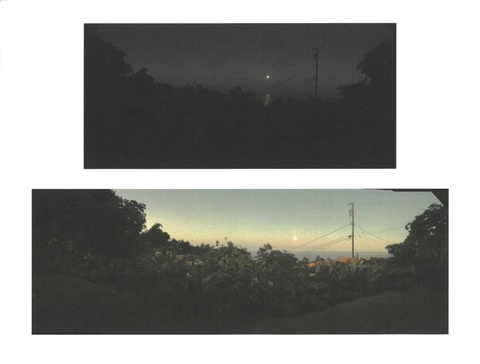
Artist Information:
Theresa Whitehill
Diptych: Dawn, Holualoa
"Full Moon Dark & Light"
10/22/2021; 11” x 14”
Color laser print on Crane’s Lettra 32# text, pearl white
Commemorating:
Nafi [or Nafia] Aboud
Professor of Arabic Literature, date of assassination unknown, university affiliation unknown
Artist Statement:
When I came across Nafi, or Nafia’s, name in the list of assassinated Iraqi academics what drew me to him or her was the lack of information about the date of his assassination or her university affiliation. Then, their ambiguity of gender was compelling, for although death is a universal, the abrupt and violent death assumed of an assassination leaves even more questions when what remains is a name that could be either a man or a woman. In this case, I found questions to be more profitable, while answers, especially those drawn in haste, were merely an avoidance of my own discomfort.
At the beginning of my journey with Nafi, I was on the island of Kona, far out in the Pacific Ocean, on the side of a dormant volcano in a place that overlooked the western horizon. Early one morning I stood on the lanai of my lodging and watched the setting of the full moon over the ocean and took two photos—one of the full moon at the first breath of dawn, and another when the sun was just bringing color out of the landscape.
Over the months since then I came to think of her in that same way I did as a child, when I used to watch with fascination how the moon kept pace with our car on the two-lane highway on the way to grandma’s, as if the moon knew me or wanted to know me, or more importantly had a message for me that would come if I kept watching.
For Nafia, I did not want to give in to the temptation to fill her anonymity with my own imaginings. I wanted to endure the tension of letting him be unknown and unknowable, to respect the emptiness, the hollowness, resisting the way that outrage and grief kept wanting to enlarge this awful entity, this assassination, fill it, expand it, in some desperate attempt to “make sense.” In the making, though, nothing beneficial. I somehow knew that to fully honor her, to be useful, I needed to refrain from painting his blankness with my own thoughts and ideas.
I held her name in my mouth without needing to swallow. I held the tension of his anonymity and of a landscape that included the threat and reality of violence as well as the evident impulse to focus a life on literature in spite of these threats and realities. In this prayer, I acknowledged how literature can both enlighten and betray, lull and invigorate, illuminate and obscure a sense of the tragedy of history. A history that includes the moon and its optical illusions as well as the specific tragedy of unknowing and the general moment when allowing the moon to set, allowing the music to end with an ungainly out of tune note, breaking off in mid-sentence if need be to convey these other
Translation:
الضوء والظل: صورة لتمجيد #319 نافع عبود
أستاذ\ة في الأدب العربي، الجامعة غير معروفة، و تاريخ القتل غير معروف
ملحوظة: لم تعرف المؤلفة ما إذا كان الاسم Nafia (مكتوباً باللغة الانجليزية) ذكرًا أم أنثى حيث (a) في آخر الكلمة يمكن أن يدل على حرف العين أو التاء المربوطة في آخر الكلمة . لذلك تخاطب الكاتبة هذا الغموض بالتنقل بين الضميرين "هي" و "هو" في مقالتها.
عندما مررت باسم نافع في قائمة القتلى من الأكاديميين العراقيين، ما دفعني له أو لها هو عدم توافر معلومات حول تاريخ الوفاة أو الجامعة التي ينتمي أو تنتمي إليها. بالإضافة لذلك إن عدم وضوح جنس الشخص، وإن كان الموت ظاهرة عالمية، يترك أسئلة أكبر حيال العنف وفجائية الموتة التي خلّفت اسمًا فقط، يحتمل أن يكون اسمًا لرجل أو امرأة. في هذه الحالة وجدت من الأسئلة نفعًا أكبر بينما كانت الأجوبة، وبالذات تلك التي استُخلصت على عجالة، لتفادي عدم راحتي الشخصية فقط.
في بداية رحلتي مع نافع كنت في جزيرة كونا بعيدًا في المحيط الأطلسي، وعلى جانب بركان خامد في مكان يعلو الأفق الغربي. ذات صباح باكر وقفت في برندة سكني، وطالعت مشهد القمر المكتمل من فوق المحيط، والتقطت صورتين، واحدة تصوّر القمر المكتمل في بداية الفجر، والثانية عندما بدأت الشمس تلوّن المشهد.
في الشهور التي تلت بدأت بالتفكير فيه\ا كما كنت أفعل عندما كنت صغيرًا، حينها كنت أشاهد بتعجّب كيف يتحرك القمر معنا ونحن في السيارة على الطريق السريع في طريقنا لبيت جدتي. وكأن القمر يعرفني أو يريد أن يعرفني، أو أن لديه رسالة لي سيبعثها لو ظللت أطالعه.
فيما يتعلق بنافعة لم أرد أن أملأ التفاصيل المجهولة بوحي من مخيّلتي. كنت أريد له\ا أن يبقى مجهولًا وغير قابل للتعريف. كنت أود احترام الفراغ والتجويف في تفاصيله، كنت أريد مقاومة الطريقة التي نتعامل بها مع الغضب والأسف بتوسعة هذه الدائرة من القتلى، أو ملئها، بمحاولات غير مجدية لإيجاد معنى لكلّ ذلك. ولا شيء ينفع رغم ذلك. عرفت بطريقة ما أنني لكي أمجّده\ا بشكل كافٍ، ولكي أكون نافعة، يجب أن أبتعد عن تلوين بياضه\ا بأفكاري الخاصة.
تمسّكت باسمها في فمي من دون أن ابتلعه. تحمّلت التوتر في التفاصيل المجهولة. تحمّلت مشهد التهديد وواقع العنف. تحمّلت النزعة التي نميل بها لتقدير الأدب بصرف النظر عن الواقع وتهديداته. في دعائي أعترف بأن الأدب بإمكانه أن ينير أو أن يخذل، أن يسكّن أو أن ينشّط ، أن يضيء أو أن يعتم تراجيديا التاريخ، ذلك التاريخ الذي يشمل القمر وخدعة البصرية كما يشمل تراجيديا عدم المعرفة، واللحظات التي يُسمح للقمر فيها بأن يغيب، وللموسيقى بأن تنتهي بنغمات بشعة، و التوقف عن منتصف الجملة إذا لزم الأمر لإيصال دلالات-
بيان وصور الفنانة: تيريسا وايتهيل
#322 Identity unknown
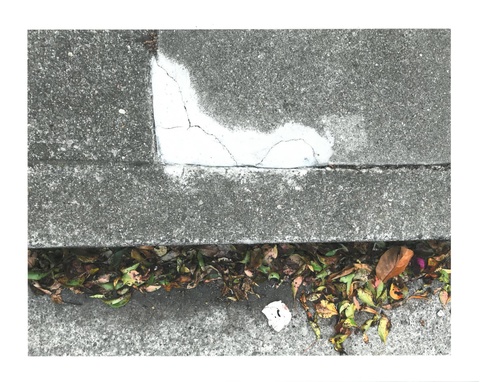
Artist Information:
Tamsin Smith - USA
“The One”
Digital Print on Watercolor Paper
Commemorating:
Unknown Identity: Specialty and University unknown. On July 14, 2010, unidentified gunmen riding in a car shot a university professor dead as he was leaving his home in the University District, West Baghdad, according to the report of an official security source. [Source: AKnews, July 14, 2010].
Artist Statement:
You were not unknown. You had friends, family, students, mentors. You had a name and a home, a neighborhood and a profession. “University Professor” – is that all the gunmen who shot you from the cowardice of their car window knew of you? Is that all that mattered to them? You wanted to know more of the world around you and leave some mark on the collective imagination. You were killed on the day your country celebrates its establishment as a republic. It’s also a national day in France, commemorating the storming of the Bastille. It is the birthday of Pierre Joris, a poet and translator of Paul Celan. Paul Celan was fluent in Russian, Romanian, French, and at least two more languages; though he wrote his verse in German. He wrote in German even though the Nazi leaders and concentration camp guards that ordered his family exterminated did so in German. Even if I knew everything there was to know about you, I’d never be able to explain the cruelty of assassins, nor the alchemical power of poetry. I can only confess that you have left a strong mark on my imagination, and then, express my gratitude.
With us, the
tossed about, yet
traveling:
the one
unharmed,
not usurpable,
rebellious
grief.
--Paul Celan, translated by Pierre Joris
Translation:
تامسين سميث
الولايات المتحدة الأمريكية
"الشخص"
الموضوع:
322. الهوية غير معروفة. التخصص والجامعة غير معروفيْن. في ال14 من يوليو 2010 قتل أشخاص مسلّحون ومجهولي الهوية رمياً بالرصاص أستاذًا جامعيًا بينما كانوا يقودون السيارة، وكان يغادر منزله في تقاطع الجامعة غرب بغداد، نقلًا عن تقرير ينقل عن مصادر أمنية رسمية. (المصدر: AKnews، 14 يوليو، 2010)
بيان الفنان:
لم تكن مجهولًا. كان لك أصدقاء وعائلة وطلاب ومستشارين. كان لك اسم وبيت وجيرة ومهنة. "أستاذ جامعي" - هل كان ذلك كل ما يعرفه عنك الرجال المسلحون الذين أطلقوا عليك النار من جُبن نافذة سيارتهم؟ هل كان ذلك كل ما يهمهم؟ وددت أن تعرف أكثر عن العالم حولك وتترك علامة في المخيلة الجمعية لمن حولك. قتلت في اليوم الذي تحتفل فيه دولتك بتأسيسها جمهورية. وهو أيضًا اليوم الوطني في فرنسا إحياءً لذكرى اقتحام سجن الباستيل. وهو أيضًا ذكرى ميلاد بيير يوريس الشاعر ومترجم باول سيلان. باول سيلان متقن الروسية والرومانية والفرنسية إضافةً إلى لغتيْن أخرتين على الأقل رغم أنه كتب شعره بالألمانية. كتب بالألمانية رغم أن القادة النازيون وحُرّاس معسكرات الاعتقال الذين أمروا بإبادة أسرته فعلوا ذلك بالألمانية أيضًا. حتى لو عرفتُ كل ما يمكن معرفته عنك لما استطعتُ تفسير وحشية القتلة، ولا حتى الكيمياء في الشعر أبدًا. أستطيع أن أعترف لك فقط بأنك تركت علامة في مخيّلتي، ومن ثم أعبر لك عن امتناني.
معنا
مازال المرميّ أرضاً
يسافر
الواحد
المسالم
الذي لا يضاهى
العصيّ على
العزاء
– باول سيلان
Translator Statements
Rochelle Davis
I am a professor at Georgetown University and my research for the last 15 years has addressed various projects related to Iraq. I am a keen follower of Beau Beausoleil’s work in Shadow and Light as well as al-Mutanabbi Street Starts Here. I thought that the Arabic-speaking world, and Iraqis in particular, should be able to see how others remember and commemorate their family, friends, and colleagues, so I sought out various student translators (Hoda, Noor, and Besan) and my colleague Mohammad to copyedit the Arabic translations. As you, the viewer, understands, reading through each of these is emotionally hollowing, and you feel the absence, the missing place of the person in the world. Because the names were in English, we had to look up each name to make sure we spelled them correctly in Arabic. We went down rabbit holes of stories about them, reading about their accomplishments and the details of their assassinations and their memorializations by their colleagues. For us, we only read the texts and did not see the photos, thus we felt more acutely the repetitiveness of assassinations by unknown assailants, which drove home the lawlessness created by the U.S. occupation of Iraq, the sudden rise of armed actors, and the fearfulness Iraqis must have felt daily. This is not to gloss over the oppressive terror of Ba’thist Iraq under Saddam Hussein, nor any roles that the academic establishment may have had in it. The texts and photos in Shadow and Light assassinated academics remind us that these professors taught students, conducted research, and wrote books that advanced human knowledge. They also invite us to remember them and honor their lives.
Translation:
أنا أستاذة في جامعة جورجتاون. تتناول أبحاثي منذ خمسة عشر عامًا العديد من المشاريع المتعلقة بالعراق. أنا من المتابعين بحماس عمل Beau Beausoleil في "Shadow and Light" وفي "شارع المتنبي يبدأ هنا". أعتقد أنه يجب على جميع العالم الناطق باللغة العربية و العراقيون على وجه الخصوص أن يكونوا قادرين على رؤية كيف يتذكر الآخرون ويحيون ذكرى عائلاتهم وأصدقائهم وزملائهم. لذلك سعيتُ للعمل مع عدة مترجمين من طلابي (هدى ونور وبيسان) والزميل محمد لتحرير النصوص المترجمة للغة العربية.
أنت كمشاهد أو قارئ لهذه النصوص تفهم إن قرائتها يترك تجويفاً عاطفي فتشعر بالغياب و المكان المفقود للشخص في العالم. نظرًا لتوفر الأسماء باللغة الإنجليزية كان علينا البحث عن كل اسم للتأكد من تهجئتها بشكل صحيح باللغة العربية. فنزلنا إلى أسفل حفرة الأرنب بحثاً عن قصصهم أو قصص عنهم وقرأنا عن إنجازاتهم وتفاصيل عمليات اغتيالهم وإحياء ذكراهم من قبل زملائهم.
نحن قرأنا النصوص فقط ولم نشاهد الصور، لذلك شعرنا بشكل بشدة تكرارية الاغتيالات من قبل مهاجمين مجهولين مما حمل لنا ثقل الخوف الذي يشعر به العراقيون كل يوم نتيجة الفوضى التي أحدثها الاحتلال الأمريكي للعراق والصعود المفاجئ للجهات المسلحة. هذا ليس لإخفاء الإرهاب القمعي للعراق البعثي في عهد صدام حسين، ولا الدور الذي لعبته المؤسسات الأكاديمية في ذلك.
فتذكرنا النصوص والصور في Shadow and Light باغتيال الأكاديميين والأساتذة الذين علموا الطلاب وأجروا أبحاثًا وكتبوا كتبًا لها معرفة إنسانية متقدمة. و تذكرنا أيضًا أن نذكرهم وأن نكرّم حياتهم.
Noor AlShaikh
I enjoyed translating poems the most. It was a challenging, yet fascinating process. I wondered: How can I transform a poem in a language that I know, yet I do not have a strong emotional connection to, into Arabic? In the process, I learned that translation entailed re-producing a piece of writing. Through the stories and emotions associated to it, I was able to navigate the barriers of languages. I learned about the power of pain in that it transferred from the victims to the artists and to us as translators. Those emotions were felt differently and re-expressed at different stages. They all communicate a unified message, which is to keep the dead alive in our memory. The thing that resonated with me the most throughout this project is our ability to remember and retell the stories and the emotions. Through this continuous process of reliving a memory, we hope that ‘their’ traces will last.
Translation:
أكثر ما استمتعت بترجمته هو القصائد. كانت عملية ترجمتها مربكة، ولكنها لذيذة. كيف أحوّل نصًّا شعريًّا كُتب بلغة أعرفها، ولكن لا تربطني عاطفة قوية بها، لنصّ آخر بالعربية؟ كان سؤالًا صعبًا. ولكن استشعار القصائد، وصدى القصص التي تدور حولها، مكّنني من إعادة كتابة النصّ، لا ترجمته فحسب. أتصوّر أن هكذا تُكتب القصائد المترجمة، أليس كذلك؟ كانت التجربة الأولى لي في الترجمة. وعيت من خلالها قدرة الألم على العبور، من الضحايا للفنّانين لنا كمترجمين. بالتأكيد، هذه المشاعر ليست موحّدة رغم التفافها جميعًا حول رسالة واحدة وهي: أن يحيى الشهداء في ذاكرتنا جميعًا، ألّا ننسى. المهمّ في هذا المشروع، هو قدرتنا على إعادة توصيف هذه المشاعر وتذكّرها. في هذه العمليّة المستمرّة من إعادة الذاكرة، نأمل أن يبقى أثرهم.
Hoda al-Haddad
I translated these letters for the purpose of introducing the world to the people behind these stories. I felt that the authors of these letters, the people to whom the letter is written in the memory of, and I have traveled together through time and space. In some way we all exist outside of our physical forms from the moment the words are written. Translating these letters has given me the honor of helping all the people behind the written words travel to a larger world where their existence will last forever.
Translation:
لقد ترجمت هذه الرسائل بغرض تعريف العالم على الأشخاص الذين يقفون وراء هذه القصص، ولقد شعرت بأني و مؤلفي هذه الرسائل والاشخاص الذي كُتبت لهم الرسائل سافرنا معًا بطريقة ما عبرالزمان والمكان ونحن موجودون جميعًا خارج أشكالنا المادية منذ لحظة كتابة الكلمات، ولقد أعطتني ترجمة هذه الرسائل شرف مساعدة جميع الأشخاص الذين يقفون وراء الكلمات المكتوبة على السفر إلى عالم أكبر حيث وجودهم باقي إلى الأبد.
Besan Jaber
The majority of the work I have done was fact checking the translated texts. I l had to look up every name of these assassinated scholars. The list is long indeed. It saddened and disheartened me. Some of these names I found in published obituaries in news articles. Other names I found in social media posts where colleagues, students and family members wrote a few words in remembrance of these assassinated academics. Reading those warm words along with the statements and poems produced by the artists, I felt deeply motivated and a little uplifted. I decided to say their names out loud even when I was alone working from my office with no one there. Working on Shadow and Light felt like an ethical obligation to me. I owe this project and its team a debt of gratitude.
Translation:
كا التحقق من صحة الحقائق والمعلومات في النصوص المترجمة هو مجمل العمل الذي قمت به في هذا المشروع . فكنت أبحث عن كل أسماء هؤلاء العلماء الذين اغتيلوا. ان القائمة طويلة بالفعل وهذا ما أشعرني بحزن وإحباط شديدين. وجدتُ بعض هذه الأسماء في نصوص نعي و تعزية منشورة في مقالات إخبارية وأخرى وجدتها في منشورات على وسائل التواصل الاجتماعي حيث كتب الزملاء والطلاب وأفراد عائلاتهم بضع كلمات تخليدًا لذكرى هؤلاء الأكاديميين والعلماء لكن كلماتهم الدافئة إلى جانب العبارات والقصائد التي أنتجها الفنانون رفعت معنوياتي وأشعرتني بالإلهام. قررتُ أن أنادي بأسمائهم بصوت عالٍ حتى عندما كنت أعمل بخلوة بمفردي في مكتبي. عملي على هذه الترجمة وكوني جزء من مشروع Shadow and Light بدا لي كالتزام أخلاقي ولذلك أنا مدين لهذا المشروع وفريقه بالامتنان.
Mohammad Alahmad
As I worked to copy edit these Arabic texts for this project, I felt sadness with no bounds. I tried to put aside my own emotions in order to produce Arabic texts that communicate the authors’ feelings and words about these departed souls. For the living reader of today, and I wish you long lives, if you find errors in the translation or grammar, I ask you to forgive us, for our minds were preoccupied, and remain so, with these souls suspended in the Iraqi heavens.
Translation:
وأنا أعمل على مراجعة الترجمة العربية لنصوص هذا المشروع كنت أشعر بأسى لا حدود له، وكثيرا ما تجنّبت أن أنساق وراء شعوري كي أُخرج نصوصاً سليمة تصف شعور أصحابها فيما يتصل بأرواح لم تسلم. أيّها القارئ الذي سلم حتى الآن، وأرجو أن يسلم إلى الأبد، إذا وجدت في هذا المشروع خطأً في الترجمة أو اللغة فاغفر أرجوك، فقد كانت أذهاننا مشغولة، وما زالت، بتلك الأرواح المعلّقة في سماء العراق. محمد الأحمد
Related programming
There are currently no events to display.
Webpage cover photo by Tariq Dajani (Jordan), "Fallen Tree" -- Shadow and Light exhibition
